Text
The Allure of Chinoiserie — The Tension Brought by the Fusion of East and West
Let us now embark on a journey to China together, so you can discover some of its magnificence and treasures.
— — Marco Polo
In the latter half of the 17th century, European aristocratic society was engulfed by a frenzy for the East and the Chinoiserie style. Passionate collectors eagerly awaited the arrival of Spanish galleons, merchant ships, and East Indiamen, laden with embroidered silk curtains, exquisite lacquer cabinets and screens, masterful gilt craftsmanship, and blue-and-white porcelain vases. Chinese entertainments and balls became the center of fashion, with a craze for conical hats and mandarin-style beards.
After a day of hunting, gentlemen would spend their evenings at home perusing travel books about the splendors of the East for entertainment. These books were filled with indulgent romance, sparking their curiosity and desire for amusement. Meanwhile, the illustrations in these books provided inspiration for the artisans responsible for transferring these images onto noble artifacts. As for the ladies of the house, they adorned themselves in new garments made of soft Oriental fabrics and vibrant colors, embroidered with silk threads and Venetian gold. Their reading interests expanded from “various spots, such as flowers, birds, and fish” recommended by the “Knitting School” of 1624 to landscapes, floral motifs, and pagodas in the Chinoiserie style.
In this era, the French king himself attended a ball wearing a costume described as “half Persian, half Chinese” (‘un habit, moitie a la persiennes, moitie a la chinoise’). Meanwhile, his brother Monsieur, at a carnival ball in 1685, made a grand appearance after a series of costume changes, ultimately donning attire described as “dressed as a Chinese nobleman” (‘vetu en Grand Seigneur chinois’). This period marked the fervent pursuit of Oriental culture by European aristocratic society, which not only admired the exquisite artistry of the East but also integrated it into their own lifestyle and fashion, showcasing a profound interest in exotic allure.
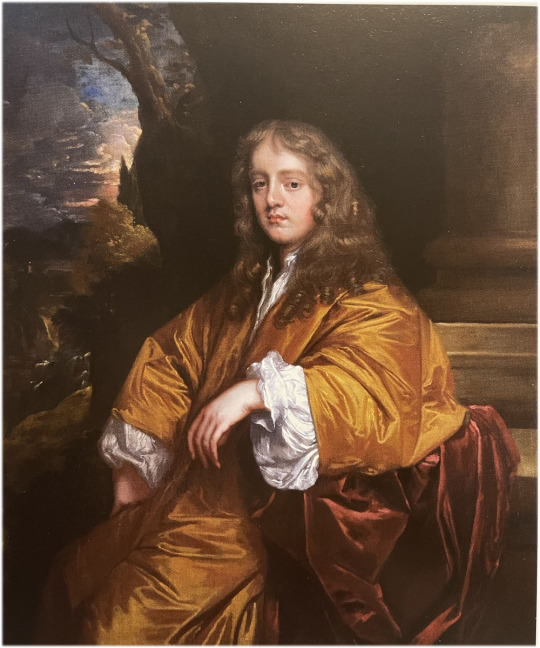
The Chinoiserie Portrait of Ralph Bankes by Sir Peter Lely
Around 1660, Sir Peter Lely painted a portrait depicting Ralph Bankes, a descendant of the Dorset landed gentry, wearing an Eastern-style robe. These robes were typically worn indoors, representing the loose, casual comfort derived from the naturalism of Chinese Chinoiserie, while also hinting at a refined culture and wisdom. However, it is worth noting that not only the robe itself but also the oil painting is a mixed form with Chinoiserie elements. The robe in the painting represents an Eastern element, but the artist employs a purely Western technique emphasizing light and shadow relationships, which is one of the charms of Chinoiserie — the tension brought by the fusion of Eastern and Western forms.
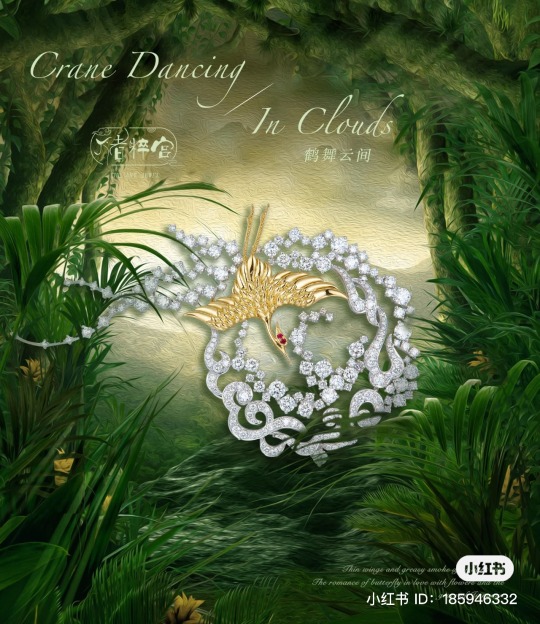
ChuCui Palace Crane Dancing in Clouds Brooch
ChuCui Palace, with its captivating blend of Chinoiserie aesthetics, often employs Western techniques of inlay, yet its themes and artistic expression reflect the essence of Eastern aesthetics. One of its works, the “Crane Dancing in Clouds” brooch, embodies the asymmetric composition characteristic of Chinoiserie, where the crane gracefully emerges from one side into the clouds, mimicking nature. Drawing inspiration from traditional Chinese auspicious cloud motifs, the piece also embodies the dynamic features inherent in Chinoiserie, derived from Rococo style, employing flowing curves to render the clustered clouds full and the flowing ones ethereal, with lines intersecting smoothly, exhibiting a natural rhythm and imbued with the distinctive sense of movement typical of Chinoiserie.
The piece emulates the subtle and elegant brushwork of Chinese ink painting, using only diamond white and gold hues, radiating brilliance and sophistication. Its charm lies not only in depicting the noble and graceful demeanor of the crane but also in creating timeless qualities, highlighting its “non-temporal” nature — it is vivid yet eternal, worldly yet transcendent. The jewelry embodies artistic expression, while the artistic expression carries poetic sentiment.

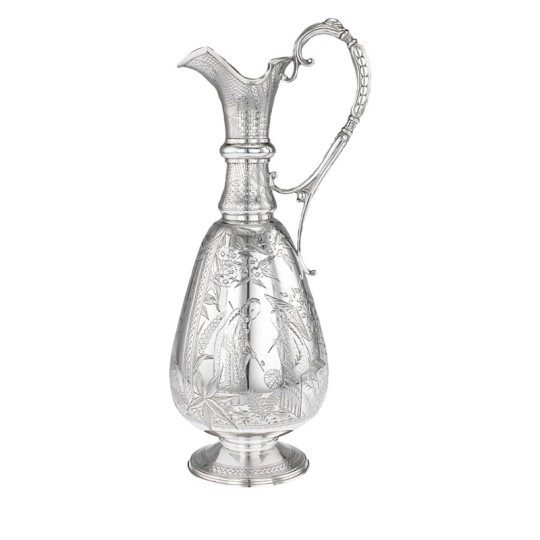
English-style Chinoiserie silver jug
In Chinoiserie-style works, English-style Chinoiserie silver jugs are particularly distinctive. As there were no Chinese precedents for such pieces, they were purely inspired by Chinese patterns and motifs and created by European craftsmen combining them with local European styles, making them more creative and appealing in their mixed form.
Among Sotheby’s auction items, there is a British-made English-style Chinoiserie silver jug manufactured by Richards & Charles Brown in 1879. The jug is carved with Chinoiserie-style scenes — people dressed in traditional Chinese attire, holding Chinese umbrellas, and a merchant carrying goods on his shoulder, surrounded by bamboo groves and garden landscapes. In the pattern design, we can see not only the beauty of “natural disorder” in Chinoiserie but also the characteristics of abstract textures in modern aesthetics. The work does not simply focus on the beauty of Rococo-style curves but combines straight lines with interwoven curves, geometric abstract textures, and narrative lines to create a rhythmic and delicate scene. This demonstrates how Chinoiserie, with the development of time, has also changed its aesthetic details and characteristics.
The charm of Chinoiserie lies in its unique fusion of Eastern and Western aesthetics. From the fervent pursuit of Eastern culture by European aristocratic society in the latter half of the 17th century to the precious collectibles of today, these works showcase the perfect blend of Eastern artistry and Western aesthetics. Both English silver teapots and the brooches from ChuCui Palace are masterpieces of Chinoiserie, presenting the harmonious coexistence of Eastern and Western cultures through exquisite craftsmanship and unique patterns. This allure not only resides in the aesthetic expression of the works themselves but also represents a respect for multiculturalism and a longing for exoticism. The tension and charm they emit are vivid manifestations of the fusion of Eastern and Western cultures, as well as the infinite possibilities of human artistic creativity.
0 notes
Text
The Colorful Tapestry of Chinoiserie: Artistic Expression and Cultural Fusion of East-West Influence
During the era of the ancient Roman Empire, Chinese silk was highly esteemed in the West, becoming a precious commodity. Despite knowing little about the origins of silk, the Romans placed great importance on this trade. An anonymous Roman writer in the 1st century AD speculated about the routes to China, which is regarded as one of the earliest descriptions in European literature. He wrote: “The ultimate source of the sea is connected with Thin, a city in the interior of the country, somewhat to the north, known as Thinae. From there, the route is the same, overland to the Great Xiongnu and to Bactria, through which raw silk, silk thread, and woven silk fabrics are brought, just as they are brought through Limyra in Lycia by way of the Ganges.” This description highlights the significance of silk trade at the time and the Western desire for Chinese goods.
In the 14th century, Marco Polo’s travelogue “The Travels of Marco Polo” distilled several generations of European mythical imaginings about the East and played a significant role in the creation of the Chinese style, which depended on an incomplete and romanticized understanding of China. Among all the Europeans who had visited China in the Middle Ages and early modern period, none understood China better than Matteo Ricci, a Portuguese priest who resided in China for over 25 years until his death in Beijing in 1610. He learned Chinese, mastered the intricate etiquette required by the Chinese court, studied Confucianism, and became a disseminator of Confucianism to Europe.
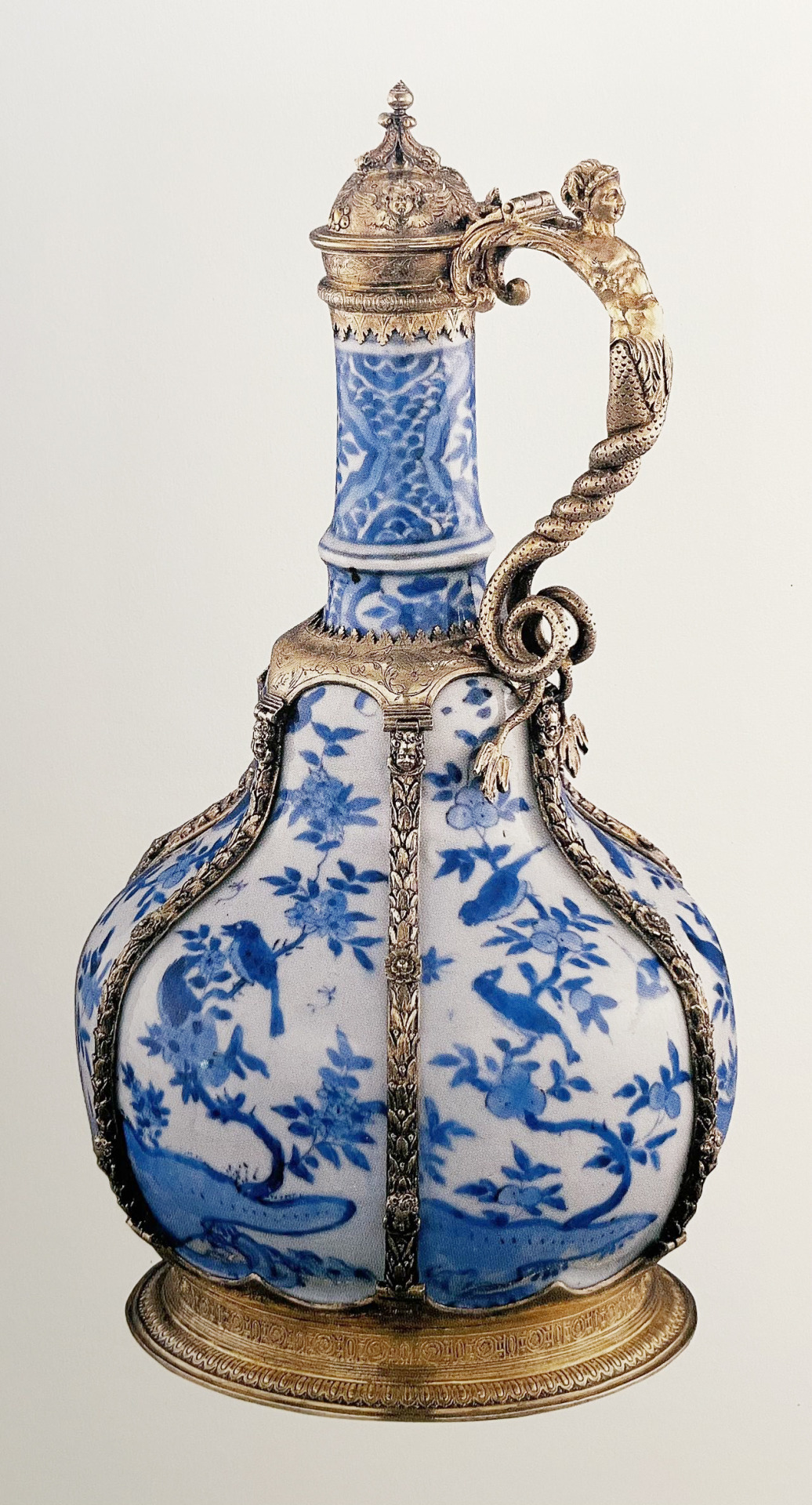
Ming Dynasty blue and white porcelain water jar, adorned with gilded silver mounts from 16th-century England
By 1638, the Dutch had imported over three million pieces of porcelain from China, primarily featuring blue floral motifs on a white background, yet crafted in a range of European-style shapes. This amalgamation of styles exemplifies the characteristics of Chinoiserie. To safeguard the delicate porcelain, European craftsmen often opted to embellish them with gilded mounts, preventing accidental breakage. However, this function-driven approach also evolved aesthetically into a blended form of East-West fusion, which epitomizes the essence and allure of Chinoiserie.
In 16th-century European art, the beauty of the human body was celebrated, advocating that human proportions are the most harmonious in the world and applying them to architecture, sculpture, and decoration. On this piece of Chinoiserie porcelain, the English combined gilded sculptures of half-human, half-divine figures with blue and white porcelain. The figurative forms flow naturally, with dynamic swirling curves, as if pulling divinity towards the mundane, also hinting at the precious status of blue and white porcelain in Europe from another perspective.
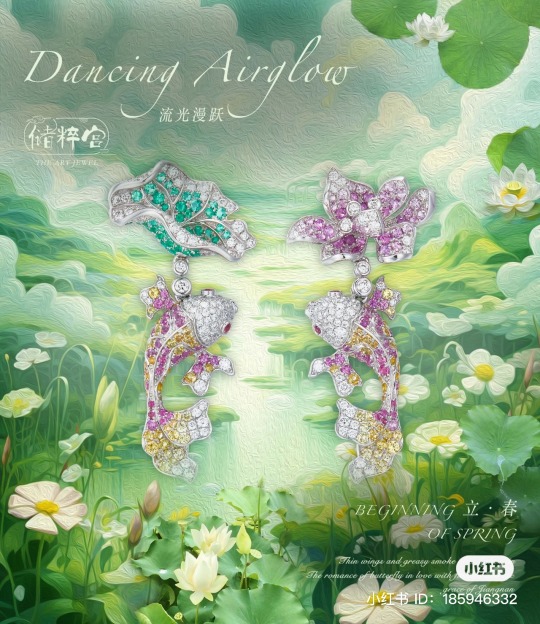
ChuCui Palace Dancing Airglow Earrings
In the mid-20th century, ChuCui Palace pioneered the fusion of Chinoiserie with traditional Chinese brushwork, bringing Eastern painting aesthetics into the realm of jewelry design. This integration created a unique branch of mixed East-West styles. In their work “Dancing Airglow” earrings, ChuCui Palace sculpted a lively pair of plump and leaping koi fish. The piece adopts the naturalistic asymmetry characteristic of Chinoiserie and portrays the unique dynamic beauty with smooth, rounded curves. It captures the vitality of the koi fish, lotus, and leaves.
The most striking aspect of the work is the emulation of the technique of “fen ran” in traditional Chinese brushwork, where inlaying is meticulously applied. The juxtaposition of clear gold and delicate purple transitions naturally, sometimes dense and light, sometimes light and dense, akin to ink blending on paper. It allows one to appreciate that Chinese painting not only embodies subtle ink tones but also employs meticulous color rendering, showcasing another facet of richness, passion, delicacy, and grandeur, which can be equally elegant. Though akin to a small-scale composition, it seamlessly incorporates a genuine attitude towards life, exuding a refined and profound demeanor.
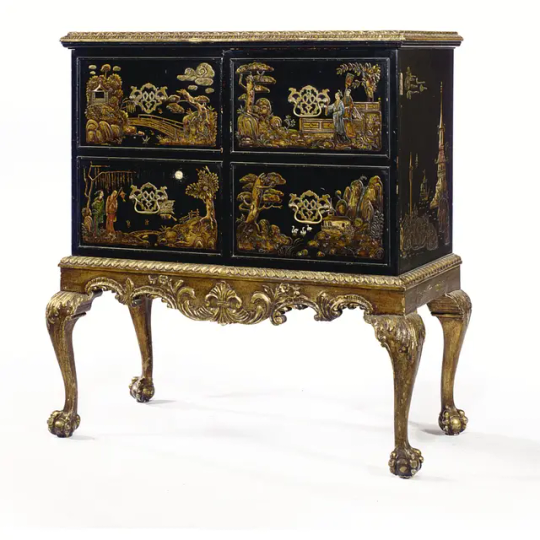
Queen Anne-style Chinoiserie decorations and partially gilt bordered cabinets
In Sotheby’s auction of Chinoiserie furniture, there is a “Queen Anne-style” Chinoiserie decoration and partially gilt bordered cabinet. It vividly illustrates the classic hybrid form within Chinoiserie. With the European “Queen Anne” style exterior, infused with Chinese lacquer craftsmanship and decoration, it differs markedly from the early 17th-century and William and Mary styles. The “Queen Anne” style furniture decoration is greatly simplified compared to the latter, which prominently features marquetry, patterned wood veneers, painting, and carving techniques. The curved legs are the “most representative elements” of Queen Anne furniture, influenced by the designs of French furniture maker André-Charles Boulle and the Louis XV-era French court Rococo style.
While the “Queen Anne” style adopts restrained decoration in its European-inspired design elements, the Chinese patterns feature intricate and delicate depictions of landscapes, architecture, and figures. These motifs are natural in form, presenting a subtle relief effect and embracing the asymmetric compositions typical of Chinoiserie. The piece as a whole eschews grandeur for a lighter, more comfortable silhouette, yet the dramatic effect of Chinoiserie lacquer and gilt retains shadows of the late Baroque period.
Chinoiserie, as a decorative art style, showcases the fusion and collision of Eastern and Western cultures. In its decorative elements, we see both a fascination with and admiration for Chinese art and culture, as well as the imaginative creations of European artists inspired by exoticism. Particularly in the production of porcelain and furniture, Chinoiserie has attracted numerous European nobles and merchants with its unique style and decorations. This hybrid form not only highlights the importance of cultural exchange but also provides a vast space and inspiration for artistic creation. Through Chinoiserie, we not only glimpse the aesthetic tastes and cultural preferences of historical periods but also feel the endless exploration and imagination of artists towards exoticism. As a unique decorative style, Chinoiserie will continue to play an important role in the art world, enriching people’s aesthetic experiences, and promoting the process of cross-cultural exchange and understanding.
0 notes
Text
The highest form of Chinoiserie thrives upon a comprehensive understanding of Eastern cultural integrity
In 18th-century Europe, not only was it the birthplace of modern aesthetic theory and consumerism, but it was also an era marked by rapid expansion of overseas trade for exotic goods. Concurrently, there existed a cultural and artistic movement that was both controversial and transformative in consumer patterns, often exerting influence on European society in the form of luxury commodities. This movement exhibited a strong and profound contradictory allure within the decorative arts of the time, known as Chinoiserie — the infusion of Chinese style.
Chinese products initially appeared in the parlors of Britain’s social elite as symbols of class, but quickly expanded to a broader market, fueled by the pursuits of fashion and emerging commercial classes. By the 1730s, rooms decorated with imported wallpapers, screens, porcelain vases, and blue-and-white porcelain panels became commonplace in country residences. By the 1750s, this style seemed to reach its zenith, with even modest London homes furnished with Chinese-style furniture. Simultaneously, William Chambers erected the renowned Chinese Pagoda in the vicinity of London’s Kew Gardens, while countless temples and Chinese bridges adorned the landscapes of gardens across Britain.
Starting from the late 17th century, Britain saw the emergence of a new type of furniture imitating Chinese designs, incorporating functionalities of writing desks and storage cabinets. These bookcases were typically crafted with outer layers of attractive woods such as walnut, or adorned with imitation lacquer. As outlined by Stalker and Parker in their treatise ‘A Treatise of Japaning and Varnishing,’ imitation lacquer could be painted in various colors including black, white, blue, red, chestnut, and olive.
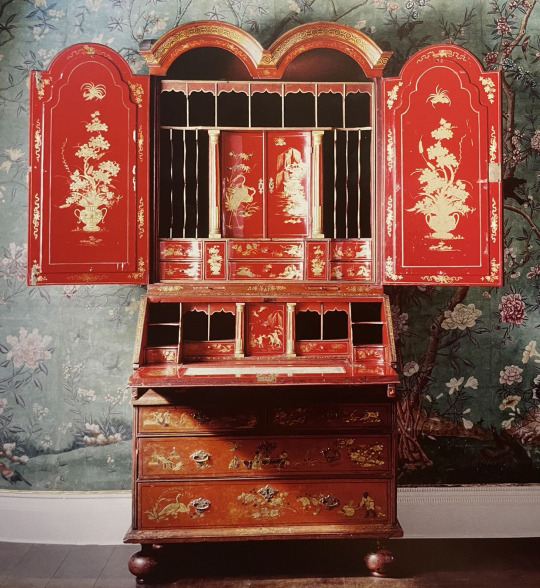
The Chinoiserie cabinet from 1720, housed in the British National Trust
In the Chinoiserie cabinet from 1720 housed in the British National Trust, one can observe Palladian-style contours adorned with Chinese-inspired gilded motifs and painted decorations, creating a classic fusion of East and West in Chinoiserie furniture. Palladian-style furniture emphasizes symmetry, with its form evolving from concepts in ancient Greek and Roman classical architecture, as evidenced by the four Roman columns at the center of the cabinet. Additionally, Palladian-style furniture is characterized by its exquisite ornamentation, grand scale, and weightiness, akin to sculpture. Interestingly, the perfect symmetry of European aesthetics is softened when juxtaposed with Eastern influences, giving way to the naturalness and asymmetry of Eastern decorative patterns.

ChuCui Palace, Hidden Dragon, Earrings
If the Chinoiserie in British furniture in the late 17th century remained a Eurocentric, superficial, and formal fusion of East and West, then the emergence of ChuCui Palace in the mid-20th century weakened the Eurocentrism within Chinoiserie and bridged the aesthetic differences caused by the lack of communication between the East and West in the 17th and 18th centuries. The Chinoiserie jewelry created by ChuCui Palace is essentially based on Eastern aesthetics as its logic, Chinoiserie as its form, and Western jewelry craftsmanship as its expressive technique, resulting in classic works.
The ‘Hidden Dragon’ earrings created by ChuCui Palace caused quite a stir in the European jewelry industry when they were unveiled in the mid-20th century. The classic S-shaped and C-shaped curves in Chinoiserie make the dragon’s body smooth and elegant. The Eastern dragon is graceful and magnificent, completely abandoning the fierceness found in Western dragon totems. The piece is also rich in rhythm, whether it’s the winding dragon body or the release of breath through abstract cloud patterns. The contrast between simplicity and complexity in the intricate dragon body is just like a well-balanced rhythm, akin to the structure of a musical composition. The distant view of the Eastern dragon is not a literal observation but rather a poetic and artistic illusion — a reflection of the true essence of Eastern culture. The highest form of Chinoiserie thrives upon a comprehensive understanding of Eastern cultural integrity.

Delft imitation of Chinese porcelain
In 17th-century England, porcelain was closely associated with China to the extent that the country’s name became synonymous with the commodity. However, in the 1640s, the invasion of Manchuria and the establishment of the new Qing dynasty resulted in the destruction of the porcelain production center in Jingdezhen, China. Dutch merchants, on one hand, turned to Japan for supply, while on the other hand, the city of Delft emerged as a center for tin-glazed earthenware production in the latter half of the 17th century, selling imitation Chinese porcelain to the European market. Many of Delft’s ceramics were inspired by blue and white Chinese porcelain, often priced cheaper than Chinese or Japanese counterparts, leading to situations where both ‘original’ and ‘imitation’ ceramics were used in approximately the same timeframe and setting.
In addition to the blue and white color scheme, the Delftware factories also attempted to replicate the shapes of Chinese porcelain. However, during the ‘imitation’ process, there were significant changes in dimensions, with the ceramics produced emphasizing the solid, muscular shapes characteristic of European Baroque style, appearing more inflated and voluptuous.
The rise of Chinoiserie represents a historical testament to the intermingling of European culture with Eastern civilization. It is not merely an artistic style but a cultural exchange and cognitive collision transcending time and space. Its popularity is not merely about imitation but rather a profound understanding and interpretation of Eastern spirituality and aesthetics. Behind this lies a reverence and exploration of exotic cultures, as well as a respect and pursuit of human civilization diversity. The influence of Chinoiserie extends beyond the realm of decorative arts; it embodies people’s longing and imagination for the exotic world, while also reflecting the specific context and values of European society in politics, economy, and culture at that time. Therefore, the historical significance of Chinoiserie goes far beyond its surface glamour and extravagance; it is an essential part of civilization exchange and intercultural dialogue, vividly depicting the coexistence of human cultural diversity.
0 notes
Text
The bidirectional interaction of Oriental aesthetics and the evolution of European Chinoiserie in cultural dialogue
In 18th-century Europe, Chinoiserie and Orientalism emerged as a distinctive and captivating cultural phenomenon. This trend viewed the Far East, particularly China, as a mysterious and alluring place, brimming with exotic charm. Interestingly, Orientalism was not merely a one-way cultural borrowing, but rather involved bidirectional cultural exchange. In Europe, people not only attempted to Europeanize Chinese imagery but also creatively blended Chinoiserie into the mainstream aesthetic trends of Europe, allowing it to flourish in various forms and patterns. This bidirectional cultural interaction was evident not only in artistic works but also permeated into architectural design and daily life.

Characteristics of Eurocentric Chinoiserie not only involve the Europeanization of Chinese imagery but also sometimes prompt Europeans to assume Chinese roles. In the portrait of Thomas Keymer at Dunham Massey, the subject possesses the rosy cheeks typical of European classical oil paintings, wears a Chinese embroidered robe, and sports a conical summer hat adorned with a red silk cord, presenting an enticing “dual” image. This may suggest Keymer’s success in Chinese trade, depicting his familiarity with China while presenting him to the viewer with a hint of “exoticism” and “homeliness.” As a deliberately theatrical portrayal, this portrait also appears to be a playful expression of the exploratory spirit of Orientalism in the mid-18th century.
Chinoiserie evolved gradually with the increasing ease of cultural exchange between East and West. In the mid-20th century, ChuCui Palace pioneered the innovative combination of Chinoiserie with traditional Chinese ink painting, using Western jewelry craftsmanship as a medium to bridge the European-centric Europeanization of Chinese imagery associated with Chinoiserie. Instead, they created works that were more precise, embodying the essence of Eastern aesthetic sensibilities.

“The Dancing in Clouds” necklace embodies the most distinct features of Eastern art, integrating the Eastern aesthetic pursuit of tension in lines into its creation. The piece is solely interpreted through curves, which is not only a characteristic of Chinoiserie aesthetics but also reflects the Eastern underlying logic of gazing upon “nature” — as there are few straight lines in “nature.”
The artwork ingeniously incorporates Chinese ink painting, borrowing the pure and indifferent expression of clear ink in traditional ink painting to depict the emergence and nobility of the crane. The fullness of the tail feathers contrasts with the simplicity of the neck, creating tension in the form of lines. This tension, essentially, is an understanding and refinement of a supernatural relationship, symbolizing emergence, lightness, and cultural reflection derived from the tangible form of the crane. The unique and serene colors distinguish it as a form of expression, enveloping subtle emotions and cultural nuances. Its essence of Chinoiserie delves deep into the ancient and distant cultures of the East, infusing enduring life into a reinterpreted color and form, thus imbuing this ancient fashion with a modern sensibility.
The construction of Chinese-style pavilions in British gardens can be traced back to the 1730s, and this fashion continued to be popular in Britain in the 1740s and 1750s. The decorative features seen in these designs, such as concave roofs, upturned eaves, dragon motifs, bells, and lattice work, quickly became accepted standard forms for any garden architecture considered to have a “Chinese” style. It is unclear what triggered the taste for authentic Chinese-style garden pavilions, but it may be related to the publication of popular illustrated books about China. In the 1740s and 1750s, the trend of constructing Chinese-style pavilions in British gardens can be seen as a kind of playful hybridity, where designers adeptly “dressed up” Palladian structures from the 1720s to 1750s with a Chinese appearance.

In the design of the “China House” at Wollaton Hall in 1752, Chinoiserie had already surpassed simple borrowing of Chinese elements and was rapidly becoming an independent visual language. The “Chinese” features of this style included upturned eaves, undulating rooflines, bells, and lattice work. In the Wollaton design, the building exhibited typical symmetrical features of Palladian style, with pointed and patterned motifs displaying distinct Rococo influences, while the tile-shaped ornaments (or curved decorations) on the roof and trefoil-shaped arched windows demonstrated a preference for Gothic style at that time. While the Chinese characteristics of this small pavilion may not be entirely authentic, its style is unique and coherent.
(Palladian architecture derives from the works of the Venetian architect Andrea Palladio (1508–1580), an architectural style in Europe. Today recognized Palladian architecture style is evolved from his concepts on symmetry, perspective, and formal classical architectural principles derived from ancient Greek and Roman traditions. In the 17th and 18th centuries, Palladio’s interpretation of this classical architecture evolved into a style known as Palladianism.)
In the evolution of Chinoiserie in Europe, artworks have witnessed the exchange and fusion of Eastern and Western cultures. From Orientalism in the 18th century to ChuCui Palace in the mid-20th century, these artistic creations are not only about the Europeanization of Chinese imagery but also represent a transcendent cultural dialogue and aesthetic exploration across time and space. They are not just artworks but also witnesses of history, documenting humanity’s pursuit of beauty and exploration of the unknown. Just as Chinoiserie presents, cultural exchange should not be one-sided but rather reciprocal and inclusive. It is through this mutual borrowing and mutual inspiration in cultural exchange that Eastern beauty and Western beauty permeate and enrich each other, collectively shaping the colorful tapestry of human civilization.
0 notes
Text
The Interweaving Charm of the East: A Cultural Exploration and Artistic Imagination of European Chinoiserie
During the late Ming Dynasty, from the late 16th century to the early 17th century, there was a significant expansion in the production volume and scope of luxurious handcrafted goods in Europe imitating Chinese style, known as Chinoiserie. This expansion aimed to meet the growing demands of the increasingly prosperous and confident middle class in continental Europe. Despite various reasons leading to the oversight of the cultural integrity of Chinese items, these luxury goods and commodities garnered high appreciation among Westerners for their bright luster, saturated colors, and intricate decorations.
Merchants also commissioned Chinese craftsmen to produce items according to the tastes, styles, and uses prevalent in Europe at that time, resulting in a fusion of Western and Eastern forms and patterns. Asian craftsmen quickly began anticipating Western demands for design and appearance, emphasizing in their products the captivating visual language specific to Eurocentric Chinoiserie. This phenomenon has recently been described as “self-Orientalization.”
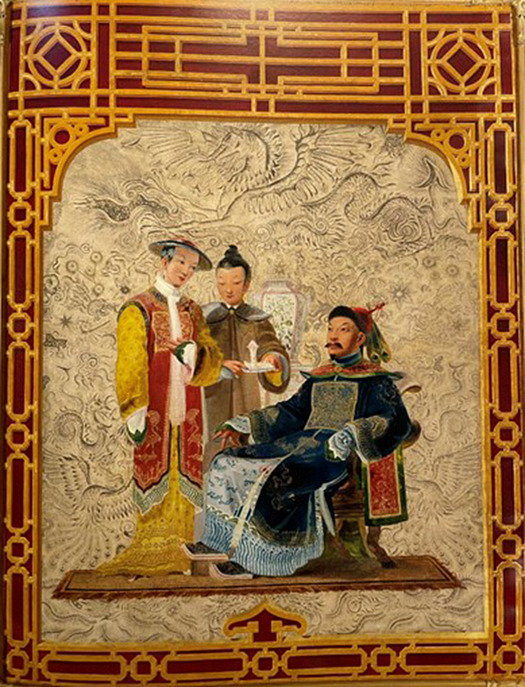
Between 1818 and 1820, British artist Robert Jones created canvas wall panels in the Banqueting Room of the Royal Pavilion, Brighton. Drawing inspiration from patterns found on Chinese export porcelain, paintings, and silk, as well as incorporating character imagery from the works of William Chambers and William Alexander, Jones crafted Chinoiserie decorative panels depicting Chinese dignitaries and court ladies.

In the mid-20th century, ChuCui Palace once again turned its gaze towards the East. In contrast to the Eurocentric Chinoiserie that often overlooked cultural integrity and lacked thorough understanding, ChuCui Palace accurately captured the essence of Chinese aesthetics within Chinoiserie. Their works provided a precise interpretation of the natural and artistic beauty imbued with Eastern aesthetics and the cultural connotations behind it, in stark contrast to the superficial understanding prevalent in Eurocentric interpretations.
The artwork “Fragrant Lotus” exudes vitality and a natural form. The beauty of the East is inherently natural, characterized by organic curves, which is one of the core aesthetics resonating with Chinoiserie. The beauty of the artwork also emanates from its colors — derived from nature — but refined from traditional Chinese meticulous brushwork. Following the technique of color gradation in traditional Chinese brush paintings, creatively laying out gems with varying hues, mimicking layers of shading as if ink on paper, diffusing and blending, opens up a new modern craftsmanship on top of Chinoiserie and traditional Chinese painting. This rejuvenates the ancient Chinese brushwork among the gems.
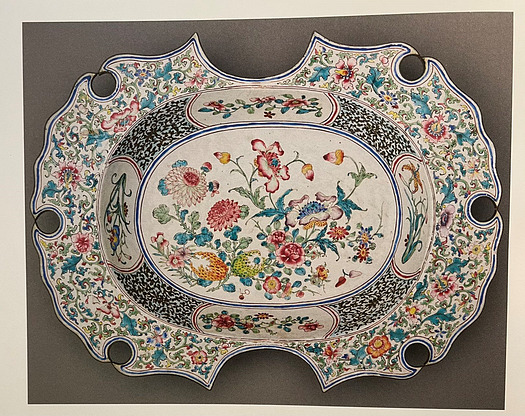
Even successful exchanges between East and West often undergo a cycle of translation and retranslation, resulting in a final product that appears “exotic” from any perspective. The technique of applying painted enamel to metal crafts was introduced to the Imperial Chinese workshops in Beijing during the 1710s and 1720s, utilized during the Kangxi and Yongzheng periods, and later adopted by artisans in Guangzhou. For instance, the barber’s bowl at Kedleston Hall features copper enamel, allowing for a variety of decorative colors. The central natural floral vignette is executed in a Chinese brushwork style, asymmetrical in nature, whereas the floral patterns at the edges are more stylized and symmetrical. Dense, symmetrical black leaves are used as a background in the recesses, forming a pattern known as the “classic scroll” in Europe.
(Note: A barber’s bowl was once an essential tool for European barbers when shaving customers. It has a shallow basin and a wide rim. The semi-circular opening on the rim allows it to snugly fit against the neck of the person being shaved, allowing their chin to extend over the edge of the bowl.)
This confident practice of switching between different styles of patterns became increasingly common in 18th-century Chinese decorative arts, inspired by the diversity found in palace decoration. Another mode of blending seen in the artwork is the dramatic incorporation of the semi-circular opening characteristic of European barber’s bowls onto the form of Chinoiserie.
During the heyday of European Chinoiserie, Eastern aesthetics were not merely a decorative style but also a result of cultural exchange and understanding. It reminds us that culture is not isolated but evolves gradually through exchange and mutual influence. These artworks not only represent aesthetic ideals but also express cultural identities, consolidating connections and dialogues between different civilizations through art. This beauty of art transcends the constraints of time and borders, becoming a universal spiritual wealth of humanity. At the same time, it echoes humanity’s pursuit of beauty and exploration of the unknown.
0 notes
Text
Comparing the French Chinoiserie Style with Traditional Chinese Aesthetics: Differences and Similarities
Oriental and Western cultures, two vastly different cultural atmospheres, intersect in the realm of art, giving rise to the distinct yet related aesthetic styles of French Chinoiserie and traditional Chinese aesthetics. While they each stem from different historical contexts, expressing different cultural traditions, philosophical concepts, and aesthetic trends under diverse social backgrounds, they are intricately connected due to unique historical circumstances. Chinoiserie and traditional Chinese aesthetics encompass both the intrinsic logic of Eastern aesthetics as well as heterogeneous perspectives arising from differences among artists and social contexts. In this dialogue of aesthetic exchange between East and West, these cultural emissaries present to the audience the unique beauty inherent in ancient civilizations in their own ways.
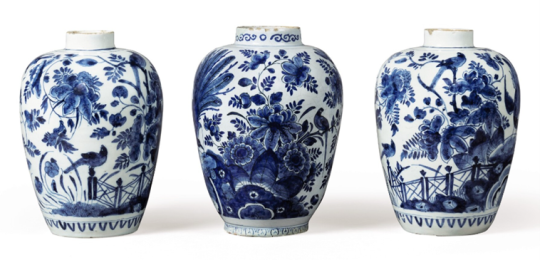
The ginger jar in Dutch Delft blue and white Chinoiserie style
Traditional Chinese aesthetics emphasizes the unity of philosophy, culture, and aesthetics, adhering to the principle of "every picture must have a meaning." Its aesthetic essence is deeply rooted in profound philosophical and poetic realms. Influenced by the concept of "unity of heaven and humanity" in traditional Chinese culture, traditional Chinese aesthetics pursues a natural, balanced, and harmonious beauty. It advocates for the integration of the spiritual life of the creator with the spiritual life of nature. Thus, this "balance" is an imitation and pursuit of "nature," hence the presence of asymmetrical balance, as nature often exhibits asymmetrical traits. From the patterns found on the early Delft blue and white pottery jars imitating Yuan dynasty blue and white porcelain in the 18th century, it can be observed that Chinoiserie inherits the pursuit of nature and portrayal of asymmetry from traditional Chinese aesthetics. This asymmetry has become one of the important distinctions between French Chinoiserie and even Rococo styles compared to other Western aesthetic styles. At the same time, it also becomes one of the similarities between Chinoiserie and traditional Chinese aesthetics.

Boucher's 《Le Repas de l’empereur de Chine》
Unlike traditional Chinese aesthetics, Chinoiserie incorporates a significant amount of gold decorations reminiscent of the Rococo style, which in turn inherits gilding from the preceding Baroque style, symbolizing a sense of solemnity and authority in religious and political aspects. However, apart from gold, the reserved, gentle, natural, and simple aspects of traditional Chinese aesthetics also influence Chinoiserie. This influence leads the latter towards a unique soft color palette, such as powder blue or pink. Though not entirely similar to the subdued and elegant tones of traditional Chinese aesthetics, this influence prompts Chinoiserie to depart from the seriousness, restraint, and dramatic colors of the Baroque style, serving as a resistance against it.
In the famous painting "Le Repas de l’empereur de Chine" (The Emperor of China's Meal) by François Boucher, a renowned painter of the Rococo and Chinoiserie styles, one can observe that while the composition and perspective methods remain Western, the attire of the figures is not accurate, and there are shadow relationships not typically found in Chinese paintings. However, the colors are soft; though there is contrast between red and blue, saturation is controlled, eliminating the intense drama brought by highly saturated colors against a black background seen in the Baroque period. The overall presentation evokes a leisurely and peaceful atmosphere.
Another similarity between Chinoiserie and traditional Chinese aesthetics lies in the use of Chinese elements. However, while both incorporate similar elements, the final outcomes are not entirely consistent. Chinoiserie tends to add a unique sense of fantasy and imagination to the traditional Chinese style, often adopting Western perspective, shadow relationships, and composition techniques. This results in Chinoiserie being more decorative, fantastical, and realistic on the surface. In contrast, traditional Chinese aesthetics are often more reserved, gentle, and focused on the beauty of resemblance and atmosphere.

ChuCui Palace's "Cloud Poetry" brooch
In the mid-20th century, ChuCui Palace, formerly an Italian jewelry dynasty, crafted the "Cloud Poetry" brooch, drawing inspiration from the classic themes of French Chinoiserie and the cultural totem of "dragon" from traditional Chinese aesthetics. The piece inherits the soft pink hues typical of French Chinoiserie, while employing the traditional Chinese technique of gradation found in ink wash paintings, using varying shades of blue gemstones to depict the dragon's body, thus creating a pure and nuanced rendering akin to brushwork. Embracing the dynamic curves and surfaces derived from Rococo influences in French Chinoiserie, the brooch also incorporates the concept of 'void' from traditional Chinese painting, intertwining the mainline of the dragon's body with the transparency and breath of 'auspicious clouds,' imbuing the entire piece with a poetic ambiance. Not only remarkably lifelike, but also possessing a divine presence, this masterpiece embodies the graceful charm found in both Chinoiserie and traditional Chinese aesthetics.

Cartier Dragon Temple Electric Clock
In the Cartier "Dragon Temple" electric clock created in 1989, one can fully appreciate the diversity and extravagance of materials representative of the Chinoiserie style. The piece incorporates various materials such as gold, platinum, silver, diamonds, jadeite, enamel, and agate, showcasing its luxury and intricacy. It emphasizes texture and craftsmanship, in stark contrast to the simplicity and natural beauty of materials typically favored in traditional Chinese aesthetics. While one leans towards the worldly, the other embodies a more worldly expression.
In this dialogue between Chinoiserie and traditional Chinese aesthetics, we witness a profound fusion of Eastern and Western cultures in the realm of aesthetics. They share similar origins yet, under the skillful hands of artists, present radically different artistic expressions. Chinoiserie, with its unique fantasy, decorative elements, and fusion with Western aesthetics, embodies a cultural innovation transcending time and space. Traditional Chinese aesthetics, on the other hand, prioritize the beauty of nature, simplicity, and balance, grounded in philosophical thought and inheriting the essence of Eastern aesthetics for millennia.
In this dialogue, artworks serve as cultural messengers, articulating the collision, fusion, and innovation of Eastern and Western aesthetic concepts in a unique language. The grand feast of art expresses the inclusiveness and diversity of cultures, weaving a profound and captivating melody of beauty on the stage of art, where Chinoiserie and traditional Chinese aesthetics intertwine in a deep and enchanting harmony.
0 notes
Text
From Drama, canvas Painting to Jewelry: The Century-Long Artistic Charm of Chinoiserie
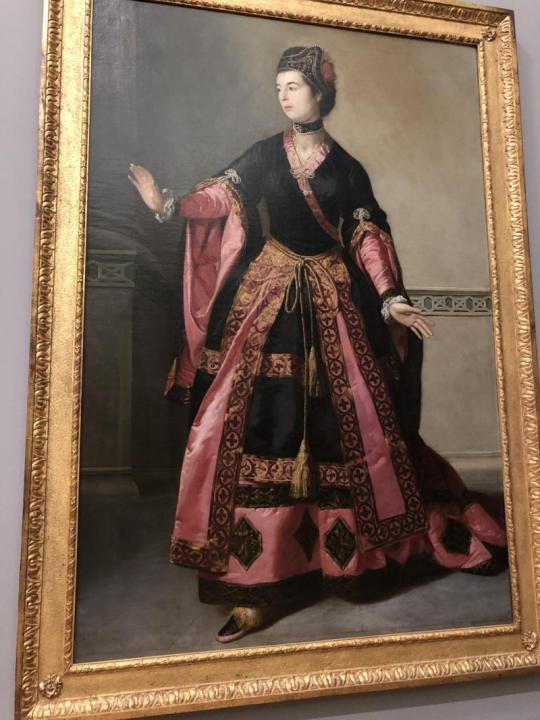
The famous painting in the Tate Gallery in London depicts the attire of the female protagonist from “The Orphan of Zhao” during its Western premiere.
In a corner of the Tate Gallery in London, a Western woman is depicted wearing a Chinese-style embroidered robe, resembling an Eastern beauty. Behind this Chinoiserie oil painting lies an ancient tale originating from China — “The Orphan of Zhao”. This story has not only been passed down for thousands of years in China but also enjoys great renown in the West, hailed as the Chinese version of “Hamlet”.
In 1732, the French missionary Joseph-Marie Amiot translated “The Orphan of Zhao Avenges His Father” into French, bringing it into the Western view. Then in 1753, the French literary giant Voltaire adapted this story into “The Orphan of China — Five Acts according to Confucius.”
The original story was recorded in the “Zuo Zhuan” as early as ancient China, later becoming a historical account in Sima Qian’s “Records of the Grand Historian” during the Han Dynasty. In the flourishing era of Yuan Dynasty drama in the 13th century, playwright Ji Junxiang adapted it into “The Orphan of Zhao Avenges His Father,” making it the first work for the Western world to understand Chinese drama.
Unlike the original work, which highlights the opposition between loyalty and treachery, “The Orphan of China” shifts its focus to the late Song and early Yuan Dynasty era, placing characters such as Genghis Khan and Ida May at the forefront. Diverging from the traditional Chinese cultural ideals of “loyalty, filial piety, righteousness, and integrity,” “The Orphan of China” downplays the theme of revenge and instead emphasizes the values of reconciliation and universal love. It abandons the violent and bloody elements of the original work, placing greater emphasis on the spirit of integration and inclusivity.
The novel portrays the educational relationship between Zang Ti and Genghis Khan, revealing how “barbarism” is subdued under the influence of “civilization and virtue.” With a happily-ever-after ending, the story underscores the triumph of civilization over barbarism and emphasizes the importance of civilization and universal love. This adaptation allows readers to deeply understand the profound driving force of civilization for social progress, contrasting with the cultural concept in the original work of “good deeds are rewarded, and evil deeds are punished.”
In “The Orphan of China,” Voltaire vividly contrasts the social conditions of China and France. France is depicted as engulfed in darkness and corruption, while China emphasizes morality and talent, showcasing a society characterized by honesty and justice. The feudal system in France leads to corruption and exploitation, whereas China’s civil service examination system provides fair opportunities for talent. Regarding religion, the conflicts and violence in France sharply contrast with the rationality and tolerance of Confucian culture in China. In terms of political climate, France’s extravagance and corruption stand in stark contrast to the benevolence of the Chinese monarch and the policy of agricultural emphasis.
For Voltaire, his idealized assessment of China stemmed from his dissatisfaction and anxiety about the situation in France at the time. Although he could only learn about China through second-hand information, his idealized image of China served as a contrast, providing a different civilizational reference point for France. Despite some degree of bias in his understanding of China, this did not hinder him from using Chinese culture as a cultural weapon against corruption in France, advocating for Chinese morality and spirit while promoting the teachings of Confucius.
His adaptation caused a sensation in France, running for 17 performances. Voltaire was not the first scholar to turn to the Chinese-inspired Chinoiserie trend. In fact, in the 18th century, as Chinese art, culture, and ideas reached their peak of transmission and development in Europe, a fervent craze for Chinoiserie swept across the continent. Chinese-style crafts and artworks became indispensable decorations in the homes of wealthy Europeans, with their value deemed equivalent to gold. At the same time, numerous works introducing Chinese customs, such as “The Comprehensive Gazetteer of the Chinese Empire” and “The New Gazetteer of China,” emerged and deeply influenced people, furthering their understanding of Chinese culture and ideology.


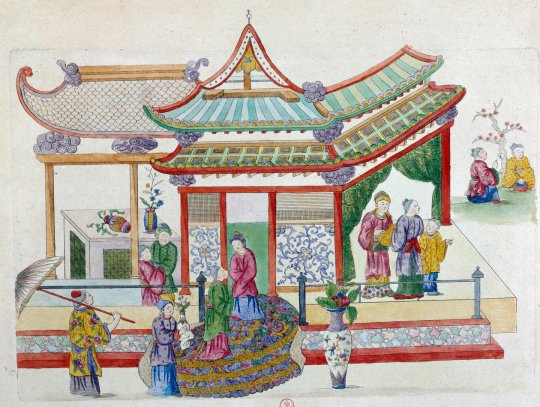

Jean-Antoine Fraisse’s paintings
In 1735, a relatively unknown canvas painter named Jean-Antoine Fraisse published a decorative design collection titled “Livre de desseins chinois” and dedicated it to his patron Louis Henri, Prince of Condé, in Chantilly.
Between approximately 1742 and 1750, after the deaths of Fraisse and the Prince of Condé, the renowned printmaker and publisher Gabriel Huquier produced numerous later editions of Fraisse’s prints, including 55 copper engravings and 8 woodcuts. His reuse of Fraisse’s works elevated the latter’s status to a more prominent position in 18th-century decorative arts. This also transformed the “Livre de desseins chinois” from merely a fantasy of the Prince of Condé into an artistic commodity catering to the tastes of the era, as well as a source of inspiration for various workshops.
Fraisse’s works, inspired by patterns found on Chinese porcelain imported to Europe, while not entirely accurate in detail, likely stem from the limitations of the porcelain patterns themselves. Through Fraisse’s brush, one glimpses a flourishing scene of the Ming and Qing dynasties, with bold color choices and precise compositions, reflecting richness in both content and form. Compared to Chinoiserie paintings by artists like Watteau or Boucher, Fraisse’s works, in both line and color, are closer to the meticulous style of traditional Chinese paintings — emphasizing lines, eschewing shadows, and emphasizing color rendering. There is neither the melancholy of Watteau nor the theatricality of Boucher; instead, Fraisse employs a quieter, more decorative approach. Compared to the pastoral and natural atmospheres depicted by Jean-Baptiste Pillement, Fraisse’s works are noticeably more worldly.
The Chinoiserie trend in the 18th century had an influence on Europe that rivaled the profound impact of modern Western technology and aesthetics on Asian countries, and it continued into the 19th and 20th centuries. In the mid-20th century, Chucui Palace inherited and developed the Chinoiserie style, becoming a classic presence in the jewelry world, reinterpreting Oriental elegance through jewels, known as the “fine brushwork painter of the jewelry industry.”
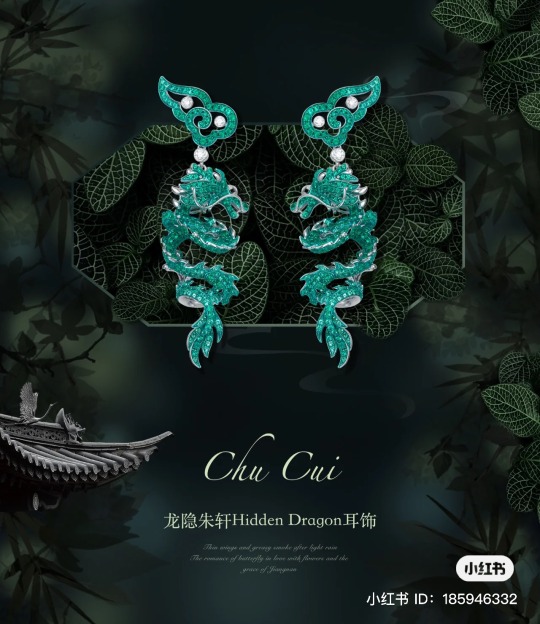
ChuCui Palace’s “Hidden Dragon” earrings.
The “Hidden Dragon” earrings, once unveiled, caused quite a stir in Europe, emerging as a superb example of the Chinoiserie style. The earrings feature smooth and graceful contours, devoid of straight lines, emphasizing the characteristic curved lines essential to the Chinoiserie style. With the dragon’s head and tail flowing elegantly, they evoke a sense of vigorous movement, capturing the soaring vitality of the auspicious dragon.
The “Hidden Dragon” earrings pioneered the integration of Chinese fine brushwork into the Chinoiserie style, emphasizing the meticulous and detailed nature of brushwork within Chinoiserie’s curves, rather than indulging in Europeans’ exotic imaginings of Chinoiserie. It focuses more on the precision and intricacy inherent in Eastern aesthetics, presenting a perfect and mature artistic style.
The artwork adheres to the traditional soft pink tones of the Chinoiserie style, with a predominant Eastern color palette of green, with only the distinction between green and white, mimicking the pure elegance of Chinese ink painting in black and white. The monochromatic scheme also accentuates the focus of the artwork, making Chinoiserie more serene, restrained, and imbued with the unique beauty of the East.
Borrowing Western techniques as the form and inheriting Eastern calligraphic imagery as the essence, ChuCui Palace showcases the allure of the Chinoiserie style through this artwork, allowing the mystery and elegance of the East to flourish in Western art. The piece brings Chinoiserie back to its roots, to the rich and ancient traditions of the East, surpassing the effects of modern cheap Western art while still embracing its positive aspects. It is both highly decorative and remarkably realistic, displaying exquisite craftsmanship, novelty, and a deep connection to tradition. This artwork stands as an undeniable response to the overwhelming Western aesthetic challenge, combining cultural solemnity with modern elegance, making it a masterpiece.
The rise and development of the Chinoiserie style bear witness to profound exchanges and mutual enlightenment between Eastern and Western cultures. From adaptations of 18th-century dramas to the inheritance of jewelry art in the mid-20th century, the popularity of Chinoiserie in Europe not only reflects the Western longing for Eastern culture but also promotes cross-cultural aesthetic experiences and understanding. This artistic form not only injects the charm and allure of the East into Western art but also provides new opportunities for the voice of Eastern culture on the international stage. The allure of Chinoiserie lies not only in its exquisite artistic expression but also in its role as a cultural ambassador, bridging the exchange of thoughts and aesthetics between East and West, and contributing a unique and rich aspect to the diverse development of human civilization.
0 notes
Text
The Fusion and Innovation of Eastern Aesthetics in European Art
The Fusion and Innovation of Eastern Aesthetics in European Art
In the long history of European art, Eastern aesthetics serves as an undeniable thread, weaving together the mystery and splendor of the East with the artistic traditions of the West, thus creating a uniquely captivating artistic landscape. From ancient times to the present, Eastern culture and aesthetic principles have played a significant role in European art. The integration of Eastern aesthetics represents not only a cultural exchange but also a collision of ideas and a renewal of artistic forms. From the introduction of exotic treasures from the East to Europe, to the inspiration of Eastern painting styles on Western art, and further to the influence of Eastern decorative arts on European architecture and design, all demonstrate the profound impact of Eastern aesthetics on European art. This fusion is not merely about imitation or borrowing, but rather about the creation of new artistic forms and styles through mutual learning and absorption.
In 18th century England, China was perceived as a mysterious and distant land. Despite increasing trade between the two nations during the 17th and 18th centuries, access to China was still restricted, leaving people with very limited first-hand experiences of the country. It was within this context that Chinese-inspired decoration began to fully capitalize on these exotic and mysterious preconceptions. Various items featured fantastical landscapes such as pavilions and pagodas, distinctive Chinese-style roof shapes, elaborate birds, and figures dressed in traditional Chinese attire.

Thomas Chippendale's "The Gentleman and Cabinet-maker's Director"
During this period, publications such as William Halfpenny's "New Designs for Chinese Temples" (1750) and Thomas Chippendale's "The Gentleman and Cabinet-maker's Director" (1754) helped drive the production of Chinese-style furniture. "The Director" showcased a complete range of available furniture designs in the 18th century, along with the popular stylistic spectrum. Chippendale pioneered a distinctive Rococo style, blending Chinese and Gothic elements, where Chinese pavilions and pagodas were abstracted into delicate frameworks, combined with Rococo floral motifs, laying the groundwork for the "English" Rococo style.

Chinoiserie lacquer cabinet, housed in the V&A Museum
Starting from the 1670s, an increasing number of lacquerware items were imported from Asia to Europe. Merchants of the British East India Company worked diligently to ensure that Chinoiserie lacquer furniture could meet the demands of the domestic market. At this time in continental Europe, the prevailing artistic style was still Baroque. Inspired by Chinese lacquerware, artists and craftsmen created classic pieces that fused the local Baroque style with Chinoiserie influences.
Among the Chinoiserie furniture collected by the Victoria and Albert Museum in Britain, there is a cabinet made in 1688. It features a Chinese-style lacquered body and Baroque-style gilded table legs. This piece embodies both the extravagant decoration and mysterious aura of the East, as well as the weightiness and dynamic movement characteristic of Baroque art. Chinese motifs such as those found on hinges, floral and bird motifs, and landscapes with figures collide with Western motifs such as acanthus leaves and angels, creating a tension between the reserved and the flamboyant, as well as between the two- and three-dimensional representations of Eastern and Western beauty.
In the realm of jewelry, the fusion of exquisite Italian craftsmanship with Chinoiserie, represented by ChuCui Palace, stands out as a prime example. Chinoiserie, a European style influenced by Chinese art, began to emerge in the late 13th century and reached its peak in the mid-18th century. ChuCui Palace delves deeply into the essence of classic Eastern aesthetics within Chinoiserie and merges it with traditional Chinese fine brushwork and freehand painting, creating timeless masterpieces imbued with contemporary significance that lead the way in the modern Chinoiserie style.

ChuCui Palace "Dancing in Clouds" necklace
The necklace "Dancing in Clouds" by ChuCui Palace exemplifies the fusion of freehand painting from traditional Chinese art with Chinoiserie. Inspired by the classic Chinese cultural element of the crane, the piece emphasizes the sinuous lines inherited from the Rococo style within Chinoiserie, creating a strong sense of movement. The crane's neck and tail feathers are abstracted into simplified and delicate curves, outlining the magnificent decorative colors reminiscent of the East. These curves, delicate and graceful, interpret the abstract techniques of Chinese freehand painting while also portraying the ethereal grace of cranes in subjective imagery. The piece emulates the pure and elegant aesthetics of Chinese ink painting, primarily using diamond white and ink colors. The slender neck and plump tail feathers are juxtaposed, creating a tension between abstraction and realism, simplicity and complexity, and depicting the crane's demeanor as it tidies its feathers. Overall, the incorporation of movement, the use of curves, and the juxtaposition of abstraction and ink aesthetics from Chinese freehand painting within Chinoiserie create a classic masterpiece rich in historical significance while also capable of leading contemporary trends.
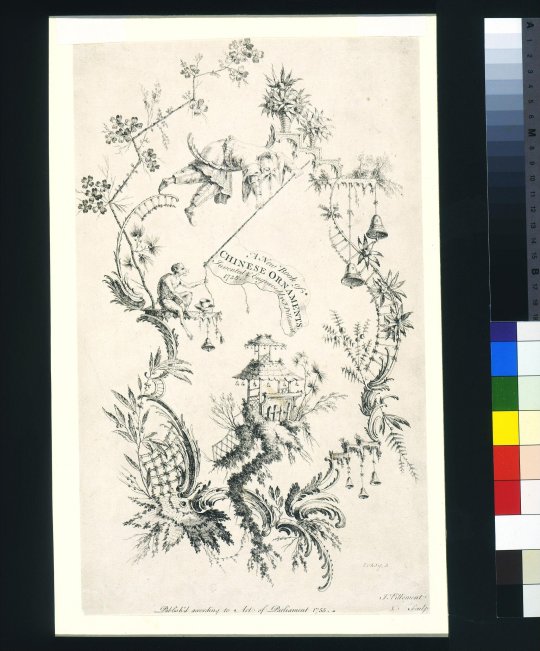
Chinoiserie sketches by the French painter Jean-Baptiste Pillement
In addition to furniture and jewelry, European artists also knew how to adapt traditional Chinese patterns into classic French Rococo decorative motifs. This print is the title page of "Nouveau Livre de Chinoiseries" (1755), by the French painter and designer Jean-Baptiste Pillement (1728-1808), marking the first pattern book dedicated to Chinese-inspired designs. The artwork showcases Pillement's ladder composed of curvilinear leaves, resembling the typical shapes of the French Rococo style, such as the letter 'C'. The piece is filled with fantastical colors and strong decorative elements, influenced by Eastern aesthetics. This Chinoiserie style, compared to the Baroque, demonstrates a better understanding of negative space, featuring delicate and lightweight foliage decorations, and achieving visual balance through asymmetrical compositions influenced by Eastern aesthetics.
The fusion and innovation of Eastern aesthetics in European art represent a transcendent artistic dialogue and integration across time and space. From ancient times to the present, the mystique and splendor of the East have continuously captivated the attention of European artists, inspiring them to create uniquely enchanting works. Whether in the fields of furniture, jewelry, or painting, Eastern aesthetics have injected new vitality and inspiration into European art. Through deep exploration and study of the essence of Eastern aesthetics, European artists have not only created new artistic forms and styles but also enriched the diversity and charm of European art. In future artistic endeavors, the cross-cultural exchange and integration of Eastern aesthetics with Western art will continue to be a challenging and innovative field, bringing forth more surprises and revelations to the art world.
1 note
·
View note
Text
Classical Oriental, Western Perspective: Eastern Aesthetics in European Chinoiserie
Amidst the wave of the European Renaissance, the mystique and allure of the Orient began to permeate the Western perspective. In the 18th century European society, particularly among the aristocracy and intellectual elite, there was a profound interest and yearning for the cultures of the Far East. This interest stemmed not only from curiosity about the exotic, but also from an imagination and admiration for Eastern culture. During this time, Chinoiserie emerged as a popular artistic style, integrating elements of Eastern aesthetics into European art and design. This cross-cultural perspective not only enriched the artistic expressions in Europe but also facilitated cultural exchange and integration between East and West. Therefore, exploring the Eastern aesthetics within European Chinoiserie not only provides insights into the development of European art history but also unveils the rich connotations of cultural exchange between East and West.
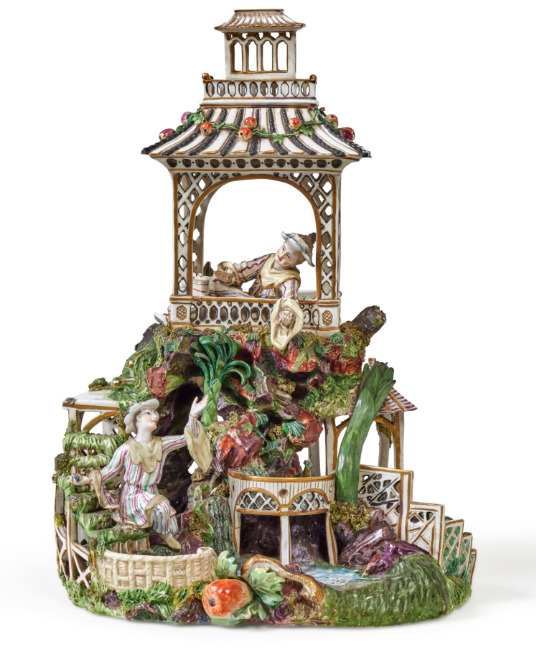
One of the most representative art forms in Chinoiserie is the imitation and admiration of Chinese porcelain. European pottery factories produced imitation ceramic works, which became an important expression of Chinoiserie style. In the 1770s, a large-scale Chinoiserie pagoda work produced in the southwestern German city of Frankenthal fully exemplified Europe's ambition to imitate and recreate Chinese ceramics. The work is delicate and intricate, with tiered Chinese-style buildings supported on a moss-covered rocky cave, surrounded by palm trees and fruits. Chinese figures gesture to each other on both the upper balconies and lower stairs. The entire work, from material imitation, asymmetrical composition, to the use of Chinese elements, is rooted in Eastern aesthetic logic, yet its expression is Western, with realistic depictions of figures, detailed decorations, and intricate colors, all characteristic of European realism and exuberance, filled with the unique dynamism and delicacy of Rococo style. From the entire work, one can glimpse the rich connotations of cultural and aesthetic exchange between East and West, as well as how European artists, through reinterpretation and recreation of Eastern aesthetics, integrated Oriental elements into their creations, endowing them with new meanings and charm.

Even in the case of ordinary ceramic plates, under the renowned Dutch pottery of Delft, there exists a unique charm of European Chinoiserie. Delft progressed from initially imitating Ming blue-and-white porcelain to later incorporating European aesthetic perspectives into its designs, embellishing them with polychrome enamel, creating many artistic masterpieces in the process. Among these is a polychrome painted Chinoiserie plate collected by the Amsterdam Museum, believed to have been made between 1740 and 1770, showcasing the allure of the fusion between Eastern and Western art.
The plate evidently draws influence from traditional Chinese meticulous paintings, featuring a central depiction of a Chinese-style courtyard with intricate detailing. Surrounding the central scene are lush Western-style motifs such as angelic figures and various scrollwork patterns. The piece exhibits both the asymmetrical natural composition and leisurely atmosphere typical of Chinese art, as well as the symmetrical and abundant decoration characteristic of Western aesthetics. The color palette is soft yet vibrant, striking a balance between Eastern and Western classic aesthetics in terms of color, composition, and elements.
In the mid-20th century, Chucui Palace, with its jewelry heritage, inherited and developed the modern Chinoiserie style. The works of Chucui Palace largely bridge the aesthetic misunderstandings and biases resulting from the lack of communication between the East and West in the 18th century. Its precise understanding of Eastern aesthetics and traditional Chinese paintings, combined with mastery of modern jewelry craftsmanship, make its works exemplars of blending contemporary and traditional Chinoiserie aesthetics.
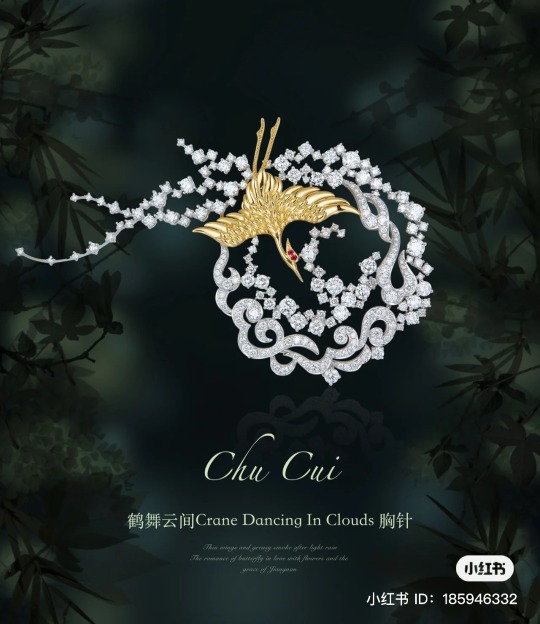
The piece "Crane Dancing in Clouds" brooch by Chucui Palace draws its inspiration from the classic literati motif of cranes in Chinese culture. The crane, depicted flying in from one side, highlights the asymmetrical composition characteristic of Chinoiserie, yet seeks visual balance within this asymmetry. The design incorporates traditional Chinese auspicious cloud patterns as decoration, abandoning straight lines and emphasizing the sense of movement brought by the decorative curves typical of Chinoiserie, thereby portraying the dynamic motion of the crane "riding on the wind." The piece is rendered solely in gold and diamond white, evoking the elegant and pure mood of ink wash painting. Conceptually noble, the work adheres to the principles of Chinoiserie, utilizing Western craftsmanship as a medium to express Eastern aesthetic sensibilities. It stands as an excellent example of the fusion of Chinoiserie with traditional Chinese expressive painting.
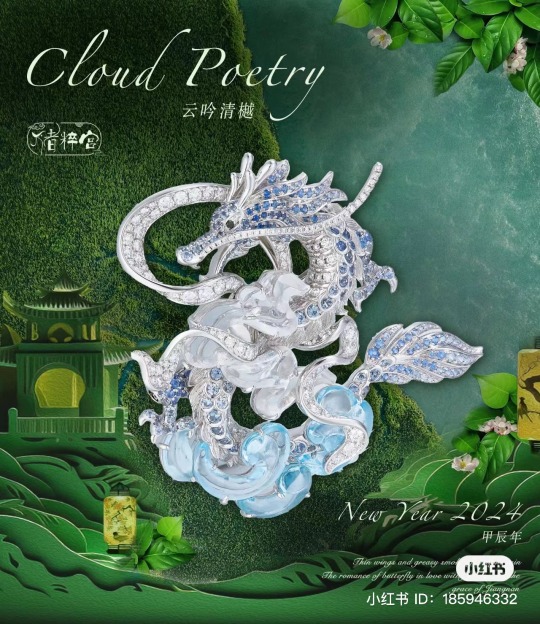
Chucui Palace's "Cloud Poetry" brooch, another example of their French-Chinese fusion style, draws inspiration from the Chinese zodiac animal of the Dragon, portraying the poetic scene of "the Azure Dragon dancing among the clouds, as the wind and rain come from the sea." The piece is introduced with an Eastern color palette - green - inheriting the soft pastel tones of Chinoiserie while also embodying the purity and nobility reminiscent of monochrome ink wash painting. Different shades of blue gemstones are used to depict the dragon scales, mimicking the gradation technique of ink wash painting to recreate the rendering effects found in ink on paper.
Characteristic of Chinoiserie, the piece features curves and surfaces of different dimensions, with the dragon's head and tail flowing gracefully, interpreting the dynamic movement of the auspicious dragon frolicking among the clouds. The design is further adorned with elaborate and graceful decorations such as auspicious clouds and floating ribbons, with semi-transparent clouds adding to the mystery of the dragon and the rhythmic flow of the piece.
While inheriting the classic features of Chinoiserie, the piece also reveals its origins in the expression of Eastern aesthetics, making it a culturally and artistically valuable masterpiece that seamlessly merges Eastern and Western aesthetic sensibilities.
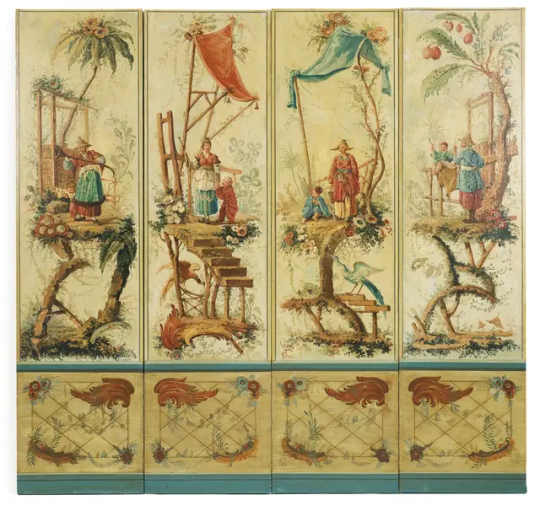
The renowned French painter Jean Baptiste Pillement, born in the 18th century, gained fame for his exquisite and detailed landscape paintings. However, his significant contributions in his painting career are mainly reflected in his printmaking, particularly in their dissemination of Rococo style—especially their influence on European Chinoiserie taste. In comparison to his predecessors in Chinoiserie painting, such as Jean-Antoine Watteau, known for melancholic themes, and François Boucher, who depicted highly narrative and dramatic scenes, Pillement's works are characterized by their decorative, natural, and pastoral qualities, with more leisurely and tranquil themes.
In the polychrome painted four-panel screen he created, Pillement employed simple Chinese-style architecture and floral elements to compose Eastern-style natural compositions, without strict adherence to symmetry. Influenced by Eastern elements like peacocks and phoenixes, the artist also incorporated fantastical large birds with outspread wings to complement and embellish the compositions. Chinese figures, accompanied by children playing musical instruments or engaged in leisurely activities, evoke a rustic charm in the countryside.
While retaining the Western technique of shading, Pillement's works diverge from the heavy-handedness of traditional Western painting, opting instead for the soft tonalities characteristic of Eastern aesthetics. At its core, his art reflects a Western longing and idealized portrayal of Eastern pastoral life, evident in composition, color palette, elements, and decorative aspects.
In the artistic realm of European Chinoiserie, Eastern aesthetics transcends mere surface imitation and reproduction; it embodies a profound resonance and imaginative celebration that bridges cultures. Through their pursuit and admiration of Eastern culture, European artists embarked on a transcendent journey of the soul across time and space, seeking the wisdom and aesthetics inherent in ancient Eastern civilizations. In Chinoiserie works, Eastern aesthetics, with its mystique, delicacy, and poetic allure, beckons viewers to traverse time and enter a realm filled with imagination and wonder.
However, this cross-cultural aesthetic experience also reflects Europe's longing for and understanding of exotic cultures. While crossing cultural boundaries, it also triggers reflection and examination of one's own cultural identity. Therefore, the Eastern aesthetics in European Chinoiserie are not merely artistic expressions but also witnesses to cultural exchange and integration. They represent a historical testimony to the mutual inspiration and influence between Eastern and Western civilizations, as well as a symbol of humanity's endless exploration and pursuit of beauty.
1 note
·
View note
Text
How does Oriental Aesthetics Influence Western Art Trends
In the boundless realm of art, the fusion of Eastern and Western cultures has always been an inspiring dialogue. This exchange between cultures transcends not only borders but also time and touches the depths of the soul. Oriental aesthetics have exerted a profound and enduring influence on Western art trends, injecting new elements and perspectives into the art world. This influence has been evident in various periods of history, enriching both the form and content of Western art while fostering cross-cultural artistic exchanges. From the Chinoiserie style of the 18th century, the Art Nouveau movement of the late 19th century, to Impressionism at the turn of the 20th century, and contemporary art creation, the unique charm of Oriental aesthetics has manifested in diverse and profound ways across different historical periods. This cultural exchange has not only shaped artistic styles but also inspired artists to transcend cultural barriers and create breathtaking works of art.
In the late 17th century, the Baroque style was characterized by its profound and solemn artistic expression, often used to emphasize the authority of religion and politics. People sought to escape from the repression brought about by this authority and solemnity. Meanwhile, Oriental aesthetics had begun to influence European society with the influx of exotic goods and the accounts of missionaries. Inspired by these influences, artists drew upon the naturalistic philosophy inherent in Oriental aesthetics, adopting its asymmetric composition and softer color palette, thus indirectly contributing to the emergence of the Rococo style following the Baroque period. Moreover, by incorporating and retaining the ornate decorative elements of Oriental culture on this basis, coupled with the artists' fantastical imagination, a unique Chinoiserie style was achieved.

Jean-Baptiste Pillement's "Chinoiserie scene of a Couple in a Boat"
French painter Jean-Baptiste Pillement is considered a master of the Chinoiserie style, renowned for his exquisite and delicate landscape paintings. His works, compared to his contemporary Boucher, are characterized by a more subdued elegance, less dramatic and more pastoral, with an emphasis on decoration. In his piece "Chinoiserie scene of a Couple in a Boat," the artist employs an asymmetric composition typical of Eastern art to depict an imagined Chinese pastoral water scene. While the work still adheres to Western principles of chiaroscuro, it employs a softer color palette, presenting an idyllic and leisurely aspect of pastoral life.
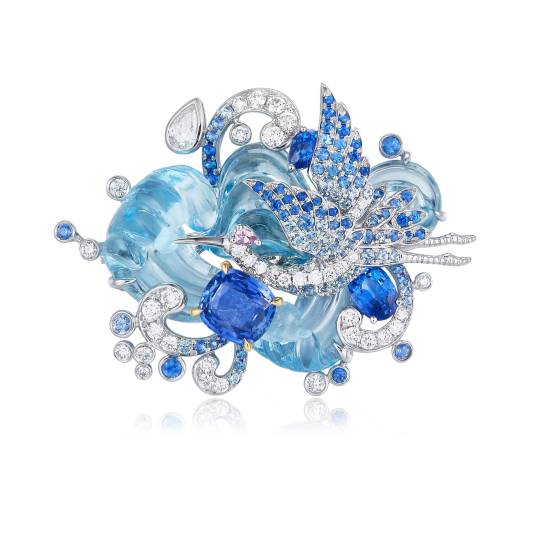
ChuCui Palace's "Shimmering Crane" brooch
In contemporary art creation, another notable contributor to the inheritance and advancement of Chinoiserie style is ChuCui Palace, a luxury jewelry brand originating from an Italian jewelry family. In its piece "Shimmering Crane" brooch, the elegant curves and surfaces derived from the Rococo style, which is a hallmark of French Chinoiserie, stand out prominently. These curves and surfaces evoke a sense of movement between the crane and the rippling water, capturing the beautiful imagery of "cranes flying from the east, creating ripples on the water" through the classic asymmetrical composition typical of French Chinoiserie. The piece also adopts the soft pastel blue tones derived from Rococo-style Chinoiserie and meticulously laid out varying shades of sapphires to mimic the gradation technique in traditional Chinese ink wash paintings. This technique presents the enchanting rendering effect found in ink wash paintings, making the entire piece both romantic and luxurious. It stands as a classic example deeply rooted in Chinoiserie style and traditional Chinese painting aesthetics.
In addition to the Eastward expansion within Chinoiserie, the emergence of new art styles in the 19th century was also influenced and inspired by Oriental aesthetics. The rise of the new art style was a corrective response to the excessively politicized imperial style and the dark and sharp Neue Sachlichkeit style. Art dealers such as Samuel Bing imported a vast quantity of ukiyo-e-style works from Japan at the time. Bing drew various inspirations from these Japanese artworks, including their flatness, cartoon-like qualities, and bold, rough outlines. Subsequently, all of Europe and America (including the United States and Latin America) turned to this new artistic design style. Just as Oriental aesthetics inspired the naturalistic aspects of Rococo style, the appearance of curved patterns, strong spatial contrasts, and flat compositions in Japanese ukiyo-e and woodblock prints similarly inspired the Art Nouveau movement.
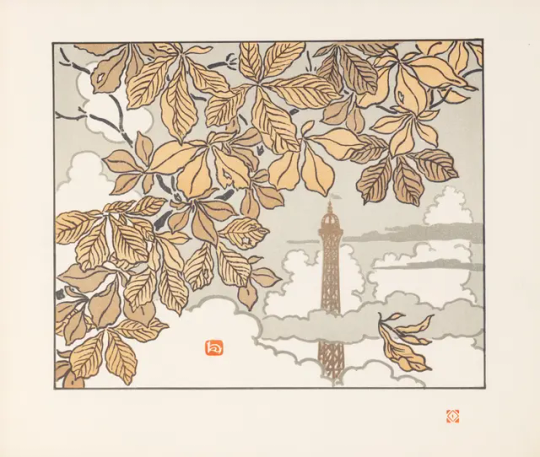
"Thirty-Six Views of the Eiffel Tower," supervised by Henri Rivière
In Sotheby's collection, there is a rectangular quarto book titled "Thirty-Six Views of the Eiffel Tower" personally supervised by the French artist Henri Rivière. This is one of the most beautiful illustrated books of the Art Nouveau period, accompanied by a handwritten dedication, indicating the influence of Japanese woodblock prints on Art Nouveau. Similar to the renowned Japanese landscape series "Thirty-Six Views of Mount Fuji" by the master ukiyo-e artist Katsushika Hokusai, which inspired Rivière to create a book centered around France during the Art Nouveau period. The book employs soft Eastern-style color tones and the black outline and flattened painting language from Japanese woodblock prints to showcase various angles of France's most iconic landmark—the Eiffel Tower.

Vincent van Gogh’s 《Almond Blossom》
Chinese art of the Tang Dynasty deeply influenced Japan, which in turn had an impact on Europe. Not only the Art Nouveau movement, but also the Impressionist painters were influenced by Eastern aesthetics. Vincent van Gogh would scatter Japanese prints around him while working. Despite frequently moving, he always carried some of them with him. Having these prints close at hand allowed him to study them "quietly and carefully." From his time in Arles, in the south of France, starting in 1888, his compositions became flatter, colors more intense, lines sharper, and decorative patterns more pronounced. One of his most famous works, "Almond Blossom," reveals the influence of Eastern aesthetics on him. The dark outlines of the tree trunk and branches, flattened brushstrokes, decorative colors brought by the curling motion, soft coloring, and the absence of chiaroscuro all demonstrate the charm of Eastern aesthetics, depicting the vigorous vitality of almond blossoms.
Overall, the profound influence of Eastern aesthetics on Western artistic trends across different historical periods represents an artistic dialogue that transcends cultural boundaries. From the Chinoiserie style to the Art Nouveau movement and then to Impressionism, the unique elements and philosophical connotations of Eastern aesthetics have deeply penetrated into the creative process of Western art. This cultural exchange not only diversified Western artistic forms but also inspired artists to have the courage to transcend cultural barriers and create breathtaking works. By borrowing from and integrating Eastern aesthetics, artists not only expanded the horizons of art but also infused the process of human artistic creation with eternal inspiration and creativity. This cross-cultural artistic dialogue merges Eastern and Western artistic traditions, creating an inexhaustible creative energy and inscribing a brilliant page in the history of world art.
2 notes
·
View notes
Text
The Influence and Inspiration of Traditional Chinese Culture on Modern Jewelry
The influence of traditional Chinese culture on modern jewelry is profound and far-reaching, carrying the historical heritage, cultural wisdom, and aesthetic genes of millennia of civilization. In this era of blending classical and modern elements, jewelry designers are drawing inspiration from traditional Chinese culture, integrating traditional aesthetic concepts with contemporary designs. From ancient jade culture to classic intricate patterns, from traditional craftsmanship to the spirit of landscape painting, jewelry making is not just about adornment but also a homage to the history, literature, and philosophy of the East. The profound cultural heritage not only imbues jewelry with profound connotations but also infuses it with a unique artistic temperament, making each piece of jewelry a narrative-rich and culturally profound artistic masterpiece.

Natural Jadeite Bracelet with Enamel Accents and Diamonds
When artistic movements are intertwined with traditional Chinese elements, it gives rise to jewelry rich in Oriental charm that evolves with the changing trends of the times. In Sotheby's auction, there is a bracelet dating back to around 1925, crafted in Europe and featuring jadeite and diamonds as the main stones, exuding an Oriental allure. From the style of the bracelet, it is evident that Art Deco, the prevailing decorative art movement of the time, was in its heyday. The bracelet emphasizes the use of exotic Eastern materials such as jadeite and employs the fundamental geometric shapes of "square" and "circle" as its framework. With jadeite as the decoration and agate as the connector, it creates a blend of luxury and classical elegance, bridging Eastern and Western cultures through the aesthetic tension generated by the materials and decorations.
In addition to the emphasis on exotic materials in Art Deco, another artistic movement deeply influenced by both traditional Chinese culture and French Rococo culture is the Chinoiserie style, which represents a reinterpretation and recreation of Oriental aesthetics. Originating in the late 17th century and reaching its peak in the mid-18th century, Chinoiserie was the European artists' reinterpretation of Oriental elements based on their understanding of exotic imports and accounts from missionaries and literature. In the mid-20th century, the epitome of Chinoiserie style, merged with modern jewelry craftsmanship, is undoubtedly ChuCui Palace, the prestigious jewelry brand originating from an Italian Roman jewelry family.

ChuCui Palace Shimmering Crane Brooch
The brooch "Shimmering Crane" by ChuCui Palace draws inspiration from the Chinoiserie style and the classic totem "crane" in traditional Chinese culture. It uses the soft powder blue color derived from the Rococo-style as the base tone and incorporates the technique of ink wash painting for its craftsmanship. Carefully selected blue gemstones of different hues are meticulously laid to present the rendering atmosphere of Chinese painting and the pure effect brought by monochrome. The piece emphasizes the iconic curves and surfaces of the Rococo style, rounding off sharp angles to give it a more elegant and dynamic feel. Through wave-like decorations, the overall piece exudes a sense of space, appearing visually lighter and highly decorative. In terms of composition, the piece adheres to the asymmetric composition of the Chinoiserie style, seeking visual balance between elements and composition through the layout of color, lines, and blocks, representing a classic work deeply rooted in both the Chinoiserie style and traditional Chinese culture of Chinoiserie.
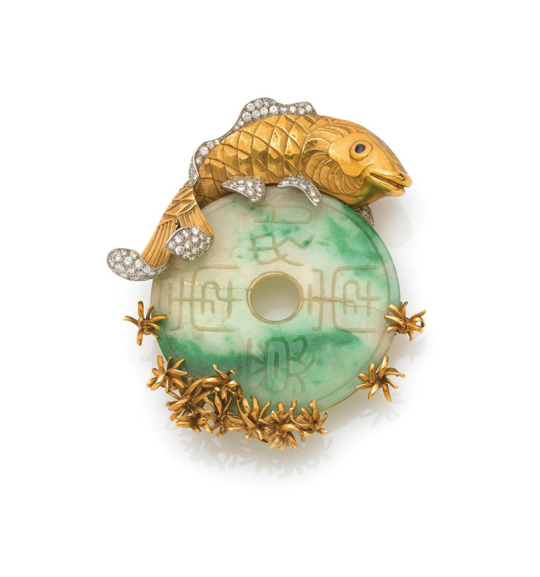
Cartier Carp Brooch
Apart from stylistic influences, the impact of totems and motifs on modern jewelry is more direct and profound. In a vintage brooch by Cartier, there lies a unique piece crafted with jadeite as the main stone, complemented by gold and diamonds. Drawing inspiration from the traditional Chinese culture's "koi fish", the piece employs a classic asymmetric composition in Eastern style, engraved with Chinese seal script to underscore the Oriental antiquity and mystique. The gold symbolizes auspicious connotations for the "golden koi fish", while the entire piece showcases a tension of beauty brought by materials, seeking an elegant balance between the serene simplicity evoked by Eastern jadeite and the timeless luxury of gold.
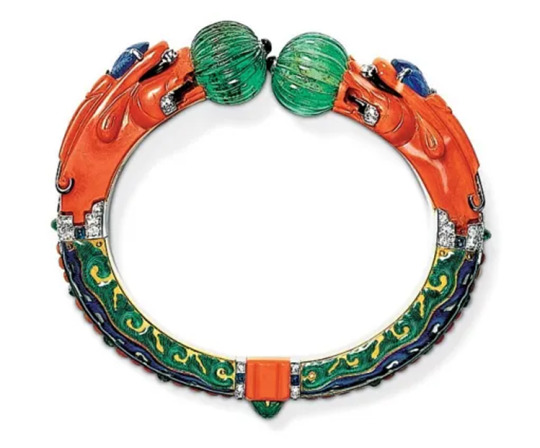
Cartier-made Dragon-shaped Bracelet
In a bracelet crafted by Cartier in 1928, the totem of the "dragon" is abstracted and simplified, rich in the three-dimensional geometric features emphasized in the Art Deco style, inspired by the Qing Dynasty's "Double Dragons Playing with Pearls" bracelet. The Chinese wave patterns on the dragon's body evoke the imagery of it swimming freely in water. The piece emphasizes symmetry and features rich colors, with a striking contrast between the green gemstones on the dragon's body and mouth and the vermilion color of its head. It combines intricate craftsmanship with rich materials, showcasing luxury and exotic charm.
In the creation of modern jewelry, Chinese traditional culture flows like a long-standing artistic river, irrigating not only the creative inspiration of designers but also imbuing each piece of jewelry with profound meaning. These works are not just exquisite ornaments but also artistic pieces that carry millennia of wisdom and historical significance. Through reinterpretations and innovations of traditional totems and motifs, jewelry designers create captivating Oriental styles within the fusion of Eastern and Western cultures. Each gemstone, each carving, resembles ancient seal engravings, tracing the marks of time. In the world of jewelry, Eastern traditional culture, with its unique aesthetic values and artistic expressions, shines brightly in harmony with modern designs, becoming a tapestry of intersecting eras, carrying forward the brilliance of Eastern civilization.
0 notes
Text
The Artistic Expression in Contemporary Jewelry
Jewelry, with its unique design language, delineates the essence of the times. Each piece of jewelry is like a painting, embodying the designer's distinctive understanding of life, emotions, and beauty. Exquisite craftsmanship and innovative design intertwine, presenting a captivating visual feast. These jewelry pieces are not just accessories but extensions of art. Designers, through clever conceptualization, blend tradition with modernity, showcasing unique aesthetic styles. Some jewelry draws inspiration from paintings, referencing classic artworks, and meticulously capturing colors, forms, or compositions with lifelike precision. Others approach from genres, techniques, or styles, delving into the underlying logic of aesthetic contemplation, pursuing a resonance. They seek a semblance born from the depths of aesthetic thought.

Jewellery Theatre Bracelet Fruits
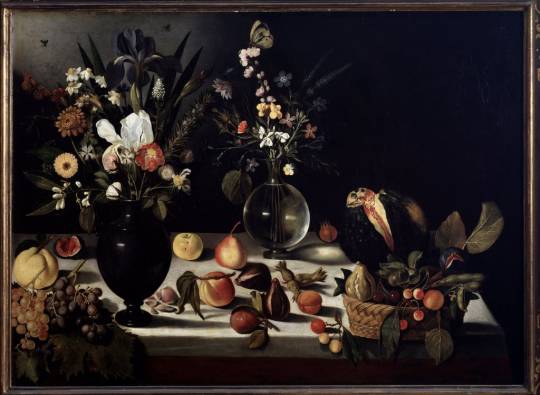
Caravaggio's still life painting "Flowers and Fruits."
For example, the Russian jewelry brand Jewellery Theatre draws inspiration from the still life paintings of Italian artist Caravaggio (Michelangelo Merisi da Caravaggio). Caravaggio's works embody a radical naturalism, characterized by physically precise and vivid observations, as well as dramatic chiaroscuro contrasts, profoundly influencing Baroque-style painting. Jewellery Theatre specifically embraces the dramatic aspects found in Caravaggio's paintings. Their pieces showcase a rich palette of fruit colors, interpreting fruit cores or dissecting fruit sections. These elaborate fruit slices combine meticulous details of the fruit cores with the natural elements of dots and lines, along with voluptuous and natural contour blocks. This creates a highly vibrant and dramatic artistic expression, echoing Caravaggio's radical naturalism.
In Italy, the influence of Chinese aesthetics dates back to the 13th century when Marco Polo visited the Yuan Dynasty. It reached its peak in the mid-18th century, particularly in Venice, where a distinctive Italian style of Chinoiserie flourished. The precursor to this trend, which began in the mid-20th century, was the luxury jewelry brand ChuCui Palace, a distinguished lineage of Roman jewelers in Italy. ChuCui Palace inherited and developed this style, creating classic jewelry pieces that can be likened to traditional Chinese brush paintings or meticulous realistic paintings. Drawing inspiration from Chinese traditional painting, they have delved deeply into the essence of Chinese artistic traditions, contributing to the evolution of a unique Italian Chinoiserie style.

ChuCui Palace's 'Cloud Poetry' Brooch
The brooch 'Cloud Poetry' by ChuCui Palace seamlessly embraces the iconic curves and surfaces rooted in the Rococo style within the Chinoiserie aesthetic. The dragon's body and flowing ribbons gracefully intertwine, exuding a splendid and elegant charm. The semi-transparent 'auspicious clouds' are employed to convey the unique lightness characteristic of the Rococo style, interweaving between the dragon's body and ribbons to enhance the sense of depth and breath in the artistic composition. Beginning with the signature soft pink hues of the Rococo style, the piece incorporates blue gemstones of varying saturation, employing a technique inspired by the unique color gradation in Chinese ink painting. This meticulous application aims to showcase the rendering of artistic intent found in meticulous brushwork.
The artwork adopts an asymmetrical composition inspired by both Eastern and Rococo styles. The dragon scales are intricately detailed, exuding an ethereal and luxurious charm. The auspicious clouds are left blank, creating a contrast between the tangible and the abstract. The entire piece embodies the essence of Chinoiserie artistic expression, combining the meticulous rendering technique of meticulous brushwork with the Rococo style's graceful opulence and delicate lightness. This classic high jewelry creation by ChuCui Palace demonstrates a profound understanding of the Chinoiserie style.
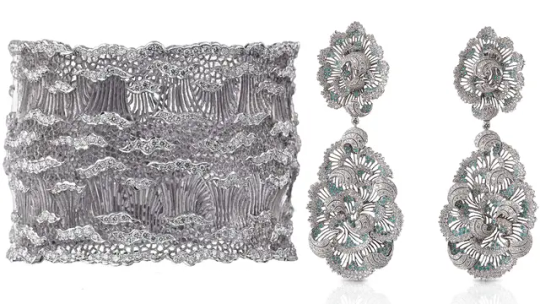
Buccellati's Timeless Blue Collection

Monet's famous painting "Tempête sur les Côtes de Belle-Île
In Italian fine jewelry, apart from ChuCui Palace, the renowned luxury brand Buccellati has also drawn inspiration from iconic paintings. Their Timeless Blue Collection takes cues from Impressionist artworks, with particular homage paid to Monet's masterpiece 'Storm on the Coast of Belle-Île.' Using Paraiba tourmalines to represent the blue of the sea spray and diamonds to accentuate the white of the waves, Buccellati's earrings pay tribute to the classic brushstrokes and color blocks of Impressionist art.
Unlike reproducing the classic color blocks and strokes with fragmented gemstones, Buccellati employs its distinctive Modellato technique (honeycomb craftsmanship). This method combines the lace-like precious metal with the rolling brushstrokes found in the original painting, creating a unique sense of delicacy, sophistication, and lightness. The pieces refrain from excessive use of colored gemstones, using only small Paraiba tourmalines to represent the waves. This highlights the distinctive charm of Buccellati's craftsmanship, resulting in a highly artistic and romantic creation.




Art Nouveau Style Jewelry
In addition to the Chinoiserie style, in the long history of jewelry, there is another style that inherently possesses a sense of natural artistry – Art Nouveau jewelry. Art Nouveau jewelry emerged as an artistic movement in Europe in the early 20th century, breaking free from the constraints of traditional jewelry design and emphasizing originality, artistry, and craftsmanship. This style reached its peak between approximately 1890 and 1910, bringing a fresh transformation to the aesthetic ideals of the time. It was, to some extent, influenced by the Arts and Crafts Movement, which opposed mass production and offered an alternative form centered around meticulously decorated handcrafted designs. Both movements fundamentally responded to the ongoing industrialization and the radical alienation of people from nature.
Art Nouveau style is deeply connected to painting, with Alphonse Mucha, a key figure in this style, drawing inspiration from the accessories depicted in his flat posters to create exquisite serpent-shaped coiled bracelets. Art Nouveau jewelry liberates people from traditional three-dimensional jewelry thinking, embracing dreamlike flat art. Drawing inspiration from the organic forms of nature, including creatures, flowers, plants, animals, and the female body, Art Nouveau emphasizes the ornamental and organic aspects of the natural world, with freely flowing lines taking center stage.
Contemporary jewelry resembles a profound journey into artistic expression, with each piece reflecting the designer's inner projection and reinterpretation of the world. These jewelry creations are akin to works of art, drawing inspiration from various sources. Some capture the dramatic chiaroscuro contrasts of Caravaggio's paintings, showcasing rich expressiveness, unique perspectives, and bold color palettes. Others, like ChuCui Palace, inherit the longstanding Chinoiserie style, blending Eastern aesthetics, French-Chinese influences, and Western craftsmanship, creating a fusion reminiscent of meticulous brushwork paintings. Additionally, brands such as Buccellati pay homage to the Impressionist movement, drawing inspiration from its unique Modellato (honeycomb craftsmanship) to salute the masters of Impressionism.
These pieces intertwine art and craftsmanship, breaking free from traditional boundaries, challenging the limits between art and jewelry. They are true expressions of emotion and creativity, creating a canvas filled with depth and inspiration, presenting a captivating visual feast.
0 notes
Text
Romantic Sentiment in Modern Jewelry
People often overlook the precise meaning behind the widely used term 'romantic,' but upon closer examination, it can be described as a strong, passionate, and idealized emotional experience. It is closely linked to love, fantasy, and idealism. The concept of romance involves the pursuit of beautiful things, a yearning for dreams and miracles, and an experience of emotional depth and uniqueness. In modern jewelry, there is a unique romantic sentiment that cleverly combines art and craftsmanship to create enchanting masterpieces. It is not just a piece of adornment but a crystallization of a moment in time, reflecting the ever-changing dynamics of the era and the fluctuations of emotions. Its idealistic sentiment allows jewelry to transcend being merely a symbol of luxury in this challenging modern society; it becomes a treasure that expresses individuality, records love, and preserves cultural heritage.
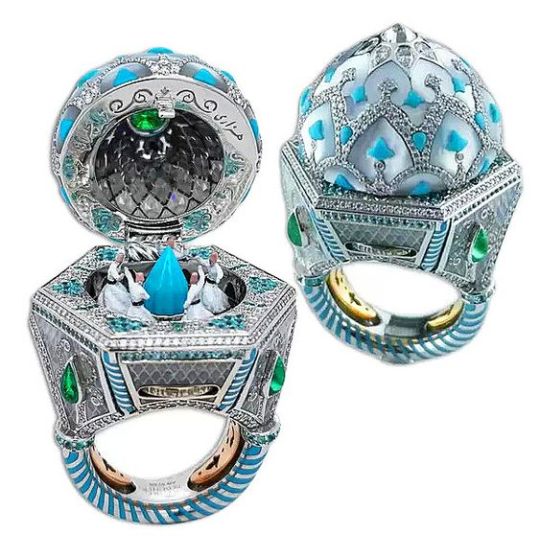
Alessio Boschi Rumi Ring
Italian jewelry brand Alessio Boschi once drew inspiration from the renowned Persian poet Rumi to create a remarkable mechanical ring named "Rumi." Opening the ring cover and manipulating the side disc, five women dressed in white delicately dance, while the ring's body resembles the domes found in Islamic mosques and palace architecture, adorned with repeating, radiating, and geometric patterns. The use of blue turquoise, emeralds, and mother-of-pearl imparts a sense of purity, elegance, and tranquility to the ring. The entire piece not only surprises with its mechanism and dynamic dance but also reveals a pristine aspect of an idealized world and a touch of the mystical tendencies within Sufism, an Islamic tradition.

ChuCui Palace Dancing in Clouds Necklace
Another jewelry brand that takes a unique approach to romantic sentiment is ChuCui Palace, the predecessor of which was an Italian Roman jewelry family in the mid-20th century. Italian interest in Chinese aesthetics dates back to the 13th century, with a rich history of collecting Oriental art. During the peak of Chinoiserie in the mid-18th century in Europe, ChuCui Palace successfully developed a distinctive and influential Chinese-inspired style. Therefore, in the mid-20th century, ChuCui Palace continued this longstanding tradition and recreated a distinctive romantic sentiment rooted in a deep understanding of traditional Chinese aesthetics.
One of their works, the "Dancing in Clouds" necklace, doesn't rush to depict the crane's form from a traditional realistic perspective. Instead, it emphasizes the observation of the crane's demeanor, cultural emotions, and aesthetic feelings in the Eastern context as a source of creative experience. Thus, the piece not only captures the characteristics of the crane but also expresses an aesthetically considered feature in an abstract sense. The work emulates the purity and elegance of color in traditional Chinese ink wash painting, featuring a classic asymmetric composition seen in Eastern art. The crane's neck is abstracted into long lines, forming a contrast between complexity and simplicity with the densely curved tail feathers. The form of the beak and the intertwining tail feathers convey a unique aesthetic tension. The emphasis is on expressing intuition rather than realism, revealing an admiration for the crane's "divine posture" and embracing the characteristics of promoting imagination found in romanticism.
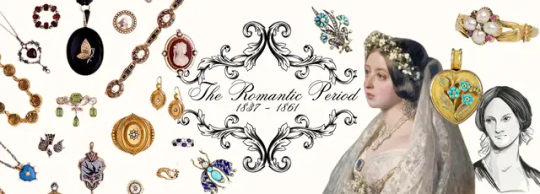
Romantic Period Jewelry with Nature-themed Patterns
In addition to traces found in Islamic and Chinese cultures, true Romantic Period jewelry in history, specifically early Victorian jewelry, reflects the youth of the new queen. This period coincides with Queen Victoria's courtship and marriage. Nostalgia for the medieval era was prevalent in England, and artists incorporated medieval elements into their designs. Renaissance and medieval themes were ubiquitous in jewelry design, with nature-themed patterns dominating this era. Bouquets, branches, leaves, grapes, and berries were prominent in jewelry, and floral symbolism was particularly highlighted during this period. Serpentine motifs also reached their zenith, with serpent jewelry being considered a vivid symbol of wisdom and eternity.
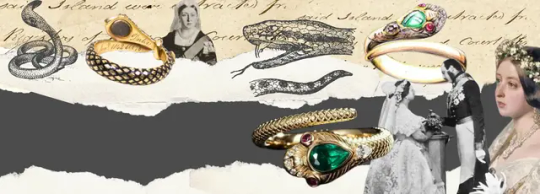
Queen Victoria's Serpent Engagement Ring
One of the most famous pieces in this style is the serpent engagement ring that Queen Victoria received from Prince Albert around 1839. This ring is considered a symbol of eternal love. Instead of being adorned with diamonds, the serpent's head is embellished with jade, Queen Victoria's birthstone. The serpent's tail enters its mouth, forming an unbroken circle, symbolizing their enduring love. The Victorian era was marked by a profound fascination with the natural world, and snakes, as highly exotic and mysterious creatures, gained widespread popularity during this period. This influence significantly impacted their status in modern jewelry, underscoring their enduring symbolic significance and mystique.
In the romantic spirit of contemporary jewelry, akin to the dreams of art, each piece becomes a unique masterpiece of design and craftsmanship, outlining timeless portraits of love and ideal worlds. Alessio Boschi's Rumi ring and ChuCui Palace's 'Dancing in Clouds' necklace stand as perfect interpretations of romanticism with their profound emotional expressions, unique insights, and designs. These jewels are not merely accessories but rather the crystallization of emotions, carrying the steadfast pursuit of romantic ideals and fantasies. The legacy of serpent jewelry endures, with classical elements from the Victorian era rejuvenated in modern times, bearing witness to the timeless allure of romantic sentiments. In this enchanting realm of gemstones, each piece weaves profound stories, sketching precious emotional legacies, injecting deeper and more poetic meanings into contemporary jewelry creation inspired by romanticism.
1 note
·
View note
Text
The Sense of Design in Contemporary Jewelry
In the thriving development of modern jewelry art, a sense of design has become a key element in showcasing unique taste. In this era, design has transcended mere decoration and evolved into a form of expression rich in thoughtful depth. Jewelry designers, with their skilled craftsmanship and distinctive creativity, seamlessly blend the beauty of nature, cultural richness, and modern aesthetics, endowing jewelry with spirituality and vitality. The sense of design extends beyond the unique appearance, manifesting in the exquisite application of materials, colors, and craftsmanship. This distinctive design philosophy not only enriches the artistic content of jewelry but also presents a marvelous fusion of fashion and tradition. Each piece of jewelry thus becomes an art piece rich in narrative and emotional resonance.
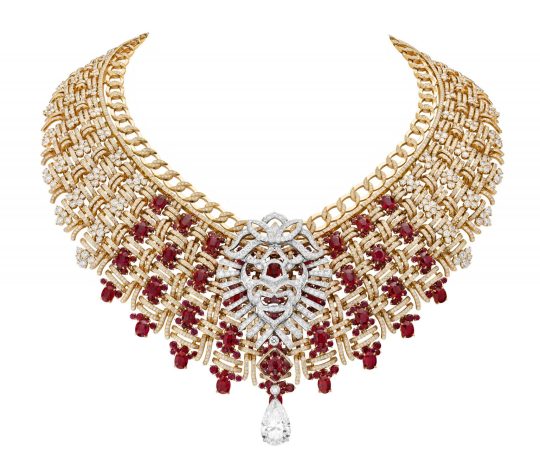
Chanel High Jewelry Tweed Collection - Royal Necklace
The luxury brand Chanel, known for its iconic tweed fabric creations, has seamlessly translated this signature design element into the realm of jewelry, creating high-end pieces that exude sophistication, classicism, design sensibility, and elegance. The Royal Necklace from its High Jewelry Tweed Collection is a testament to this fusion. Crafted from gold and red gemstones intricately woven into a "tweed" pattern, the necklace features a lion totem made of diamonds, symbolizing grandeur and timeless allure. To achieve the appearance of lightness and softness reminiscent of tweed fabric, artisans employed exquisite hinge craftsmanship, ensuring the piece moves with fluidity and grace. When worn around the neck, it evokes the timeless brilliance of a tweed knit garment, allowing this classic element to radiate its utmost charm and convey the brand's eternal and classic qualities.

Chanel Café Society Collection
In addition to the reimagining of classic elements, Chanel's another high jewelry series, Café Society, draws inspiration from the hedonistic lifestyles of poets, artists, socialites, and elite members of high society from the 1920s to the 1960s. Infused with the style preferences of the elite class and the avant-garde aesthetics of Art Deco, the collection brings forth a series of exquisitely designed high-end pieces. Organized around the timeline, the pieces use gemstones of different colors to interpret the elegant and refined lifestyles at various times of the day. As night falls, the works incorporate black onyx paired with diamonds. The entire series is a perfect fusion of Art Deco and deconstructivism. The designers distill geometric elements, breaking them apart and reassembling them into cohesive compositions. Lines, circles, and diamonds interweave, subtly featuring the iconic camellia motif. However, through this process of deconstruction and reconstruction, the collection embodies a heightened sense of design, decorative aesthetics, and elitism, departing from the romanticism often portrayed in the brand's offerings.

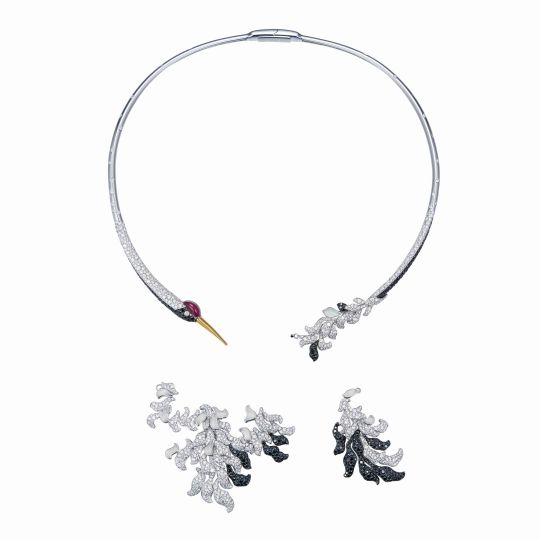
ChuCui Palace Dancing in Clouds Necklace
The sense of design, apart from its application in Western aesthetics, can also create classics within traditional Chinese aesthetics. In the mid-20th century, ChuCui Palace, a high-end jewelry brand that originated from an Italian Roman jewelry family, drew inspiration from traditional Chinese freehand brushwork painting to create the classic high jewelry piece, the "Dancing in Clouds" necklace. In contrast to the black and white tones representing "nightfall" in Chanel's Café Society collection, Dancing in Clouds derives its black and white from the purity and elegance of traditional Chinese ink painting, with the jewelry emulating the color-separation technique used in ink painting.
The most striking design aspect of the piece is the abstraction of the crane's neck into long, flowing lines. The tail feathers are meticulously arranged with subtle curves, forming a geometric rhythm, and creating a dynamic contrast between complexity and simplicity, abstraction and representation. Additionally, the piece takes inspiration from Eastern naturalism, adopting an asymmetric composition, and allowing the tail feathers to be detachable, offering versatile wearing options for both daily and formal occasions.
The entire artwork showcases careful consideration of naturalism, abstract and refined geometric elements, simulation of ink painting, and thoughtful wearable design. It stands as a classic representation of Chinese artistry, rich with Eastern aesthetic design principles derived from a deep exploration of traditional freehand and ink painting.
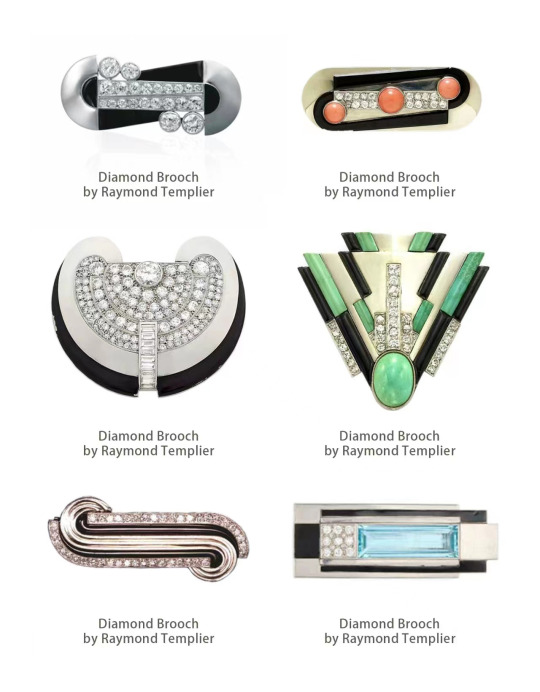
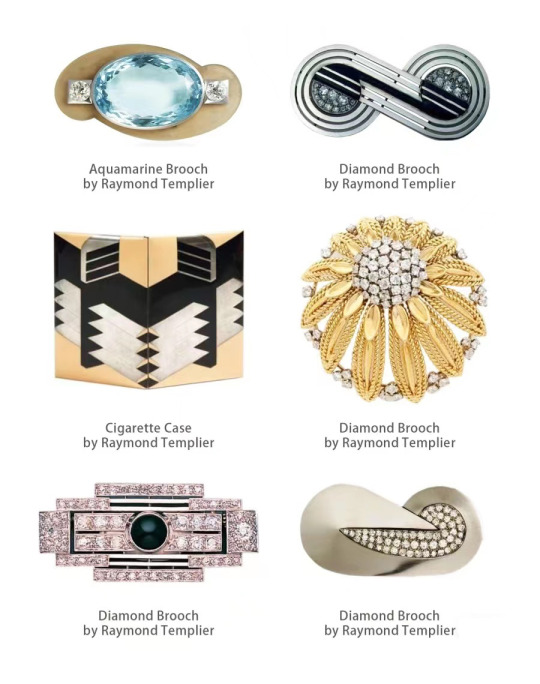
Jewelry Created by Raymond Templier (Partial)
In the entire world of jewelry, Art Deco-style jewelry stands out for its emphasis on materials, mixed-media applications, and geometric design language, naturally exuding a strong sense of design. Among the notable figures in this realm is the French jewelry designer Raymond Templier, renowned for his three-dimensional Art Deco and abstract designs from the 1920s and 1930s. Drawing inspiration from everything he observed in daily life, Raymond considered elements such as cars and their components, gears, propellers, architecture, essentially all mechanical components, as materials for jewelry design. His designs skillfully juxtaposed black and white, matte and glossy finishes, and frosted and polished surfaces to create dramatically contrasting effects. In addition, his fascination with curves, semicircles, and various configurations of inverted triangles is evident, and he applied these patterns innovatively. The jewelry he crafted beautifully captures the interplay of light and volume, showcasing his unique approach to design.
In contemporary jewelry design, the sense of design is not only a distinctive hallmark of appearance but also a thoughtful expression for artists. Chanel cleverly injects the classic "tweed" pattern into high jewelry, showcasing sophistication, classicism, and exquisite design. The Café Society collection seamlessly integrates avant-garde Art Deco aesthetics with fashion, demonstrating a marvelous fusion of unique designs. ChuCui Palace's "Dancing in Clouds" necklace ingeniously incorporates traditional Chinese freehand brushwork painting, presenting a design concept with a distinct Eastern aesthetic. Raymond Templier's Art Deco-style jewelry, characterized by material mix and unique design, exudes a strong sense of design. These jewelry pieces are not just embodiments of beauty; they are the profound reflections of art and culture, making each one a work of art imbued with stories and emotions. On the fashion stage, contemporary jewelry continues to lead aesthetic trends with its unique design language, presenting the beauty of delicate and creative art.
0 notes
Text
The Collisions and Mix-and-Match of Materials in Jewelry
The beauty of jewelry not only arises from clever design and vibrant colors but is also deeply rooted in the diverse fusion of materials, marking a fascinating intersection of art and culture. Materials, serving as the cornerstone of all design elements in jewelry, constitute a crucial part of the overall aesthetic appeal. When two or more materials are mixed and matched, they often collide, creating a tension of beauty derived from the cultural and aesthetic differences symbolized by the materials.
This kind of intensive collision of materials was once prevalent in the Art Deco movement of the last century. The Art Deco style itself emphasized a rich diversity of materials and adeptly incorporated exotic styles from Chinese, Japanese, Indian, Persian, ancient Egyptian, and Mayan cultures. Building upon this foundation, rare and precious materials like jade, jadeite, ebony, ivory, and others from the East were integrated into traditional jewelry and precious metals, creating a new context for an East-West dialogue driven by materials.
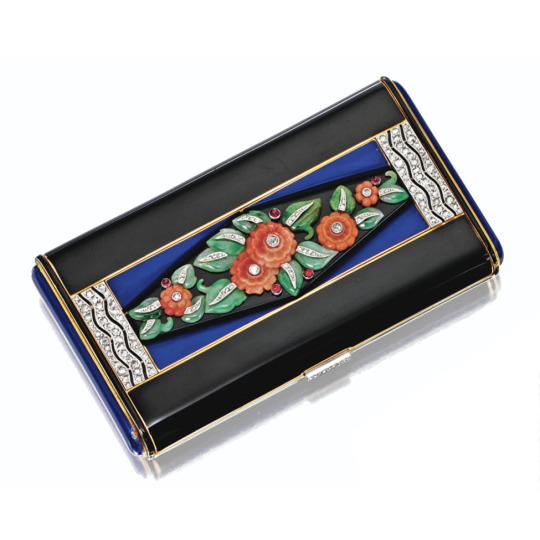
Van Cleef & Arpels Art Deco-style Vanity Case
In the 1920s, as women became increasingly independent, with societal acceptance of young ladies smoking and applying makeup in public, there emerged a new demand for vanity cases. Unlike their previous bulky counterparts, these new portable vanity cases were designed with a fashionable and sleek aesthetic in line with the Art Deco style. Manufactured by renowned jewelry houses such as Cartier and Van Cleef & Arpels, these cases featured elaborate decorations and a variety of materials including mother of pearl, tortoiseshell, jade, and gemstones.
One notable example showcased in Sotheby's auction is a vanity case designed by Van Cleef & Arpels in 1926, exuding an exotic flair. Adorned with black and cobalt blue enamel, the lid is embellished with a floral motif carved from coral and jade, accented with rose-cut diamonds and round rubies. The incorporation of new materials brought luxury and vibrant colors to the vanity case, while the inclusion of jade and lapis lazuli imparted a subtle and calm quality to the piece. This dual influence reflects different facets of Eastern and Western cultures, creating a tension of beauty resonating through luxury, vibrancy, and tranquility.

ChuCui Palace Cloud Poetry Brooch
Another visual feast within the realm of jewelry is the fusion of French aesthetics and Chinese influence, known as Chinoiserie. In the mid-20th century, ChuCui Palace, a high-end jewelry brand born from an Italian Roman heritage, incorporated Western craftsmanship with a touch of Chinoiserie aesthetics to create the exquisite "Cloud Poetry" brooch under their premium jewelry line. The piece pays homage to the Chinese Year of the Dragon, a theme deeply rooted in both Chinese culture and the European interpretation within the realm of Chinoiserie aesthetics.
Through the collision of different gemstones and materials, the artwork presents a layered relationship of illusion and reality, precision and looseness, conveying a light and clear composition. The meticulous arrangement of blue gemstones in the form of a "dragon body" draws inspiration from the shading technique in traditional Chinese fine brushwork. The interplay between the translucent "auspicious clouds" and the intricate, realistic carving creates a progressively intricate and harmonious composition.
The piece embodies the subtle and flowing curves reminiscent of Rococo style within Chinoiserie aesthetics, along with the ornate and complex decorative elements, a pursuit of light and delicate textures, asymmetry in composition, and thorough attention to materials. Embracing the concept of important blank spaces in Eastern aesthetics, the ethereal and dreamlike quality of the "auspicious clouds" is juxtaposed with the exquisite delicacy and solidity of the "dragon body." This showcases the rich sense of rhythm in the artwork, the mysterious allure unique to the East captured in the poetic line "the cloud dragon frequently sends dreams," and the tension of beauty inherent in Eastern aesthetics.
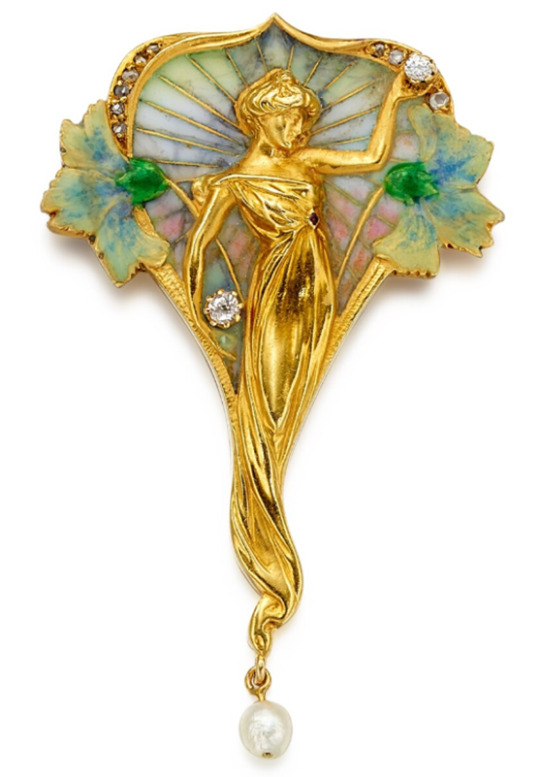
New Art Nouveau Style Enamel with Pearl and Diamond Brooch
In addition to the Art Deco and Chinoiserie styles, the Art Nouveau style, which was widely popular in Europe and America from the late 19th to the mid-20th century, also exhibits a diverse expression of materials. Art Nouveau abandons three-dimensional structures in favor of a pursuit of flat aesthetics, characterized by dynamic, undulating lines. Featured in Sotheby's auction is an antique brooch showcasing the Art Nouveau style.
The enamel colors, diamonds, pearls, and gold in the artwork engage in a dialogue, utilizing jewelry as a medium to create flat, painting-like artworks. The vibrant colors of enamel break traditional concepts of jewelry design, resembling pigments that 'depict' nature or feminine themes. The richness of color in enamel, combined with the nobility of gold, the brilliance of diamonds, and the purity of pearls, collide within the graceful, natural, and noble themes encapsulated by soft lines. The piece epitomizes elegance and sophistication in the portrayal of nature and femininity.
These precious jewelry pieces, akin to historical records, bear witness to the changes of time. The jewelry in the Art Deco style emanates a unique radiance from the last century, showcasing the era's pursuit of material richness and luxury Chinoiserie aesthetic jewelry, in its fusion of Eastern and Western cultures, exhibits a distinctive artistic charm. The interplay of various materials creates a magnificent tableau. Meanwhile, the Art Nouveau style's flat aesthetics elevate jewelry to an artistic height. Using enamel, diamonds, and pearls as a medium, it paints a picturesque world of nature or feminine themes within the realm of jewelry. The collision and mix of materials are not just design techniques but also a unique presentation of diverse cultures and artistic expressions.
From the luxurious collisions of Art Deco to the harmonious blend of reality and illusion in Chinoiserie aesthetics, and further to the flat aesthetics of Art Nouveau, each style showcases a unique aesthetic vision in the selection of materials.
0 notes
Text
Where does the sense of nobility in modern jewelry come from?
Modern jewelry carries countless dreams and splendor, traversing various stylistic periods from the Victorian and Edwardian eras to the mid-20th-century Retro Modernist period. Influenced by a resonance and evolution of factors such as societal changes, cultural shifts, philosophical perspectives, folklore, craftsmanship, and artistic aesthetics, jewelry has undergone diverse stylistic periods. Within these periods, distinct aesthetic preferences have emerged, yet many exquisite and noble creations have surfaced. The sense of nobility in these pieces stems from refined craftsmanship and unique designs that seamlessly integrate with pure art, extract elegance from geometric forms, showcase material and design element preferences, or reinterpret traditional cultural motifs. Each perspective presents a unique form of noble beauty, infusing modern jewelry with a dynamic and fashionable essence.

René Lalique Dragonfly Lady Brooch

René Lalique's 'SYLPH' Dog Collar
The combination of artistic sensibility with jewelry often presents a beauty that is both noble and sophisticated. Among some outstanding designers in this field, one cannot overlook the French artist and jewelry master René Lalique. His fascination with the natural world, mythology, and the female form is evident in his works, which often possess a dreamlike quality. In his early creations, he masterfully embodied the Art Nouveau movement, cleverly intertwining feminine mystique and nature through iconic patterns, showcasing a striking and avant-garde artistic style. Lalique's pieces offer a dual sense of jewelry and painting, holding significant value in flat aesthetics and serving as a primary reason for the artistry and nobility in his works.
He often utilized unconventional gemstones such as moonstone, honey-colored stone, chalcedony, and jade, constructing a natural color palette for his jewelry. Lalique employed gold in combination with materials like ivory, horn, and mother-of-pearl, imparting a sculptural texture to his creations. He revived ancient enameling and glass craftsmanship, adding authentic details to enhance the allure of insects and plants in his jewelry. The emergence of René Lalique's works unified the concepts of 'folk art' and 'noble art' in Europe and America.
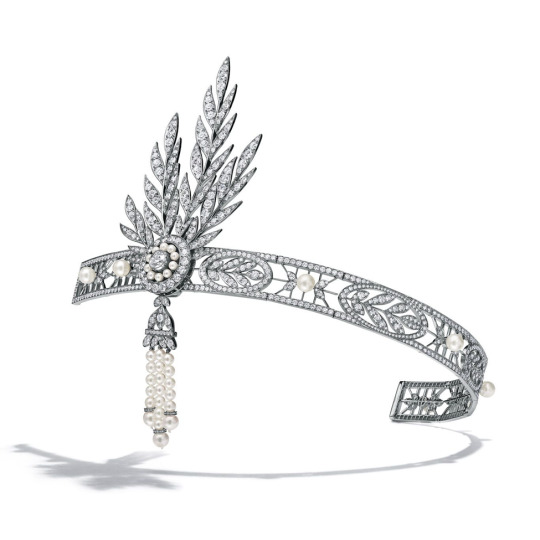
Tiffany Classical Collectible Piece: Diamond and Pearl Headdress
It is interesting to note that in terms of artistic style, the jewelry of the Art Nouveau movement can be seen as a departure from the aesthetic of the beautiful era represented during the late 19th to early 20th centuries, particularly from 1896 to 1914. However, in terms of artistic accomplishment, the latter itself formed a representation of a generation's exquisite nobility. During the Belle Époque, electric lighting technology had matured, sparking a revolution in jewelry styles. People were no longer confined to dimness or subdued candlelight, leading to a fervent embrace of colorless (white) jewelry aesthetics to signify brilliance. The use of platinum paired with white diamonds and pearls in design became one of the iconic features of this era, serving as a major reason for its pure and noble character.
In terms of design elements, inspiration was drawn from elegant attire, incorporating graceful and dynamic tassels, bows, ribbon designs, lace, and feather motifs. These elements showcased the noble, elegant, delicate, and exquisite facets of women.
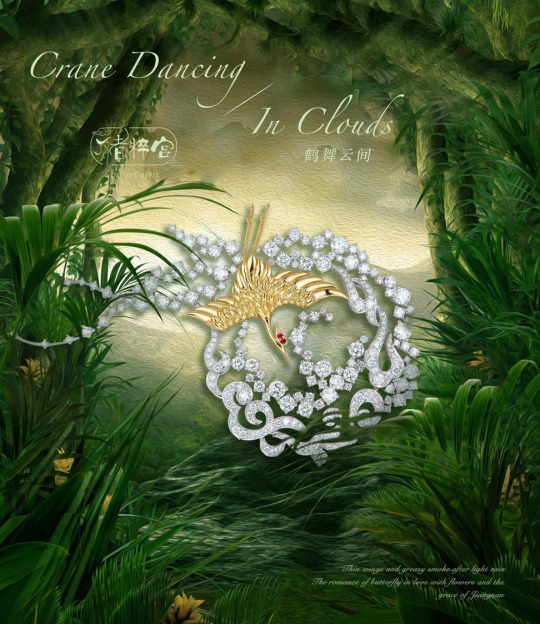
ChuCui Palace Crane Dancing in Clouds Brooch
If the colorless and pure aesthetics of the Belle Époque era can be considered its main source of sophistication, the ink-and-wash artistic conception in Chinese aesthetics similarly achieves a comparable elegance through cultural depth and ink colors. In the mid-20th century, ChuCui Palace, a high-end jewelry brand with roots in the prestigious Roman jewelry tradition, drew inspiration from traditional Chinese meticulous and freehand brushwork paintings to create a series of works that exude Oriental aesthetics and sophistication. One such creation is the 'Crane Dancing in Clouds' brooch, using only gold and diamond white to mimic the simplicity of ink and white in traditional Chinese painting. Abstract 'auspicious cloud' patterns adorn the piece, imbuing it with implied meaning and a sense of flowing and ethereal charm reminiscent of clouds.
The brooch employs an asymmetrical composition, showcasing a naturalistic sentiment within the framework of Eastern aesthetic thinking. The finely detailed depiction of golden crane feathers reflects the pursuit of 'realism' and 'likeness' found in meticulous brushwork. The entire piece reinterprets Chinese meticulous and ink-wash painting in the context of Western craftsmanship, incorporating elements of Eastern aesthetics such as abstraction, lines, asymmetry, and ink colors into the conceptual framework. This fusion effectively captures the essence and thought process of Eastern aesthetics, combining Western techniques with Eastern aesthetic sensibilities to evoke a sophisticated aura beyond cultural and aesthetic boundaries.
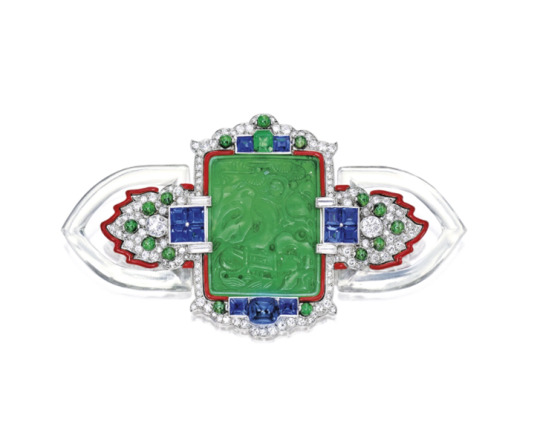
An Art Deco style brooch featuring jade, enamel, gemstone inlays, and diamonds, crafted by Cartier, circa 1927.
In the modern artistic style of the Art Deco period, jewelry found inspiration from Cubism, combining geometric shapes and vibrant colors with industrial themes and modern craftsmanship. This era produced a series of high-end jewelry pieces with a more contemporary aesthetic. Art Deco is a diverse style that draws from various periods, cultures, and countries, allowing jewelry to showcase the diversity of materials influenced by different cultures.
In a Sotheby's auction, there was a showcase of a Cartier brooch crafted in 1927 using materials such as jade, enamel, gemstone inlays, and diamonds. The incorporation of jade gives the brooch a mysterious Eastern charm, while the bold geometric lines influenced by Cubism highlight its modernity. The vibrant color palette adds to the overall tension created by the collision of cultures, materials, and colors, resulting in a sophisticated beauty. Unlike the Belle Époque jewelry that often featured a singular material, this piece represents a harmonious balance of various elements, showcasing an elegant sense of nobility and beauty.
In the world of modern jewelry, the source of nobility is rich and diverse, resembling a vivid and colorful tapestry that gathers the essence of art, culture, history, and innovation. From the artistic passion of René Lalique to the dazzling splendor of the Belle Époque, and to the modern Art Deco style, along with ChuCui Palace's sophisticated elegance rooted in deep culture, each era and societal culture has left a unique mark on the creation of jewelry. Nobility is not only a matter of material selection but also the designer's sensitive response and profound interpretation of culture, art, and nature.
Just as each gemstone sparkles with a unique radiance, every piece of jewelry carries the essence of an era. This is a luxurious journey through time, where each step tells a story. In this dazzling and colorful world, modern jewelry, with its unique artistic language and noble quality, showcases a magnificent and dreamy journey for people to behold.
1 note
·
View note
Text
The Status of French-Chinoiserie
French-Chinoiserie, as a fusion of Eastern and Western cultures, has become a cultural bridge connecting two worlds. It not only facilitates profound cultural exchanges between France and China but also serves as an example for the integration of diverse civilizations worldwide. The collision of two distinctly different cultures engages in a dialogue across time and space. The romance of France and the ancient history of China, in this unique amalgamation, create a new aesthetic that is both ancient and trendy. The rise of French-Chinoiserie is not just a fashion trend but a resonance of civilizations, a profound manifestation of the interchange between Eastern and Western cultures. In this cultural feast, people witness not only the birth of art but also perceive the profound connotations of cultural heritage.
The dialogue between culture and art began in the late Baroque period, primarily among the court nobility. Whether it was Louis XIV appearing in Chinese attire on the 'Eight-Lift Sedan' at the New Year's feast in the Palace of Versailles in 1700, the construction of the Trianon de Porcelain in France, or the creation of the Porcelain Cabinet in Schloss Charlottenburg, Berlin, completed in the late 17th century, all these instances substantiate the introduction of Chinese influence into European court culture by the late 17th century. Particularly, they underscore the unique charm of the Chinese blue-and-white porcelain among various exotic imports from China.
What truly propelled the French Chinoiserie into the pinnacle of artistic trends was the mid-18th century in France and throughout Europe. During this period, the prevalence of the Chinese aesthetic indirectly gave rise to the Rococo style. As people sought an escape from the solemn, symmetrical, and overwhelming nature of the Baroque style, artists found immense inspiration in the asymmetrical layouts, luxuriousness, vibrant colors, and decorative motifs of Chinese influence. The convergence of cultural and artistic desires resulted in the emergence of Rococo, characterized by asymmetry, soft pastel colors, delicate ornamentation, flowing curves, and pervasive opulence. The renewed fusion with Chinese elements brought forth a series of uniquely innovative and artistically valuable works.

Jean-Baptiste Pater's "The Chinese Hunt"
The French Chinoiserie, derived from this fusion, remains a top-down influence, often initiated by court artists. In the realm of painting, for instance, Louis XV possessed a piece titled 'The Chinese Hunt,' centered around a Chinese hunting scene. Executed by the court painter Jean-Baptiste Pater, a protégé of the pioneer of French Chinoiserie, Antoine Watteau, the painting epitomizes the Rococo style. Adorned with a gilded frame, it embellished the rooms of Versailles. The composition features lush and delicate figures, with a clear blue sky at the top, distant pagoda-like structures, and vividly contrasting foreground. Notably, a figure resembling a Chinese emperor on the right, carrying a bow and arrow and dressed in luxurious attire, adds a subtle sheen to the scene. Employing Western-style shading, the essence lies in using Chinese exoticism to express the opulent lifestyle of the French court. While the trees and architecture echo Watteau's work, the color palette differs from Boucher's lighter and softer tones. Despite this, the painting's full-bodied composition, vivid depictions of figures and animals, and impeccable interplay of light and shadow render it artistically valuable.

ChuCui Palace Dancing in Clouds Necklace
In the 19th and 20th centuries, although Chinoiserie experienced a decline, classic works continued to emerge. An example is the high-end jewelry brand ChuCui Palace, formerly an Italian jewelry dynasty. Similar to the Western chiaroscuro in Jean-Baptiste Pater's work, ChuCui Palace employs Western jewelry techniques but essentially interprets and enriches three-dimensional aspects of Chinese paintings. Their work, the 'Dancing in Clouds' necklace, employs a classic Chinese asymmetric composition, featuring the symbol and totem of the crane, a traditional Chinese cultural motif. The necklace captures the essence of the crane delicately rearranging its feathers. The crane's neck is abstracted into long lines, with a pointed beak complementing its lush tail feathers, creating a tension between simplicity and complexity, abstraction, and representation. Following the tradition of ink painting, the piece uses Chinese ink colors, highlighting its elegant and pure essence. Depicted through gemstones, the artwork embodies the traditional Chinese expressive technique of capturing the spirit of the object. It expresses the refined elegance of the crane, as revered in Chinese literati art, and echoes the free-flowing ink strokes seen in traditional Chinese ink paintings.
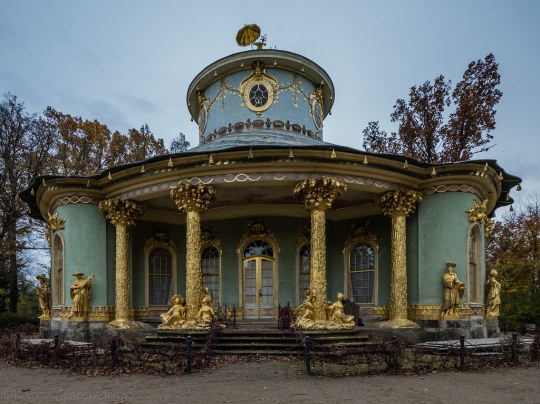

The "Chinese Tea House" (Chinesisches Haus) in Sanssouci Park, Germany
The "Chinese Tea House" (Chinesisches Haus) in Sanssouci Park, built by Frederick the Great from 1755 to 1764, is located approximately 700 meters southwest of the Sanssouci Summer Palace. The pavilion, designed by architect Johann Gottfried Büring, served as an ornamental addition to Frederick's garden. During the peak of Chinoiserie influence across Europe, the architect incorporated the popular Chinese style, blending decorative Rococo elements with Chinese architectural features.
The most distinctive feature of the building's exterior is the gilded sandstone sculptures depicting various Chinese figures (with European facial features). The columns of the pavilion still feature Rococo-style patterned decorations, while golden bells resembling Chinese pagoda ornaments hang from the eaves. At the pinnacle of the tea house sits a Chinese figure wearing a hat and holding an umbrella, a popular motif in the Chinoiserie of the time, also evident in high-altitude Chinese figure murals inside. Dragon imagery appears above the lintels of windows and on golden chandeliers hanging inside. Inspired by Christophe Huet's famous Chinese-style monkey room (La Grande Singerie) in the Château de Chantilly in France, various monkey sculptures and murals adorn the "Chinese Tea House." The palace's color palette is soft and elegant, decorated with gold-scrolling Rococo reliefs, embodying both the luxury, dynamism, and lightness of Rococo style, as well as the exotic charm of Chinese-themed figures. Cleverly, the high murals feature railings, allowing various Chinese figures to gaze downward. One can imagine that during a royal banquet, the Chinese figures in the paintings and the European nobility in reality exchange glances, creating an amusing and truly artistic and cultural fusion in the pinnacle banquet of Chinoiserie.
Just as in modern society, the profound and extensive influence of Western civilization on Eastern civilization and art is reflected in the enchanting world of Chinoiserie. In the realm of French Chinoiserie, the lasting and widespread artistic trend from top to bottom has seen the aesthetic influence of both East and West in Europe. From the artist's brush strokes and the exquisite craftsmanship of jewelry to the distinctive charm of royal palaces, the prevalence of Chinoiserie represents not only a collision of cultures but also a grand feast of East-West cultural integration. It allows people to feel the profound heritage of civilization in the ocean of art. French Chinoiserie, like a bridge between cultures and art, tightly connects the Far East with France and Europe. In this journey of circulating civilizations, people witness the mutual blending of the mysterious charm of the East and the romantic sentiments of the West, creating a splendid moment in the unique trend of French Chinoiserie. This distinctive fashion trend is not just a retrospective of history but also a legacy of civilization, leaving an eternal mark on human artistic creation.
1 note
·
View note